Managing Customer Experience : Thomas Cook
VerifiedAdded on 2021/02/21
|18
|5621
|71
AI Summary
Contribute Materials
Your contribution can guide someone’s learning journey. Share your
documents today.
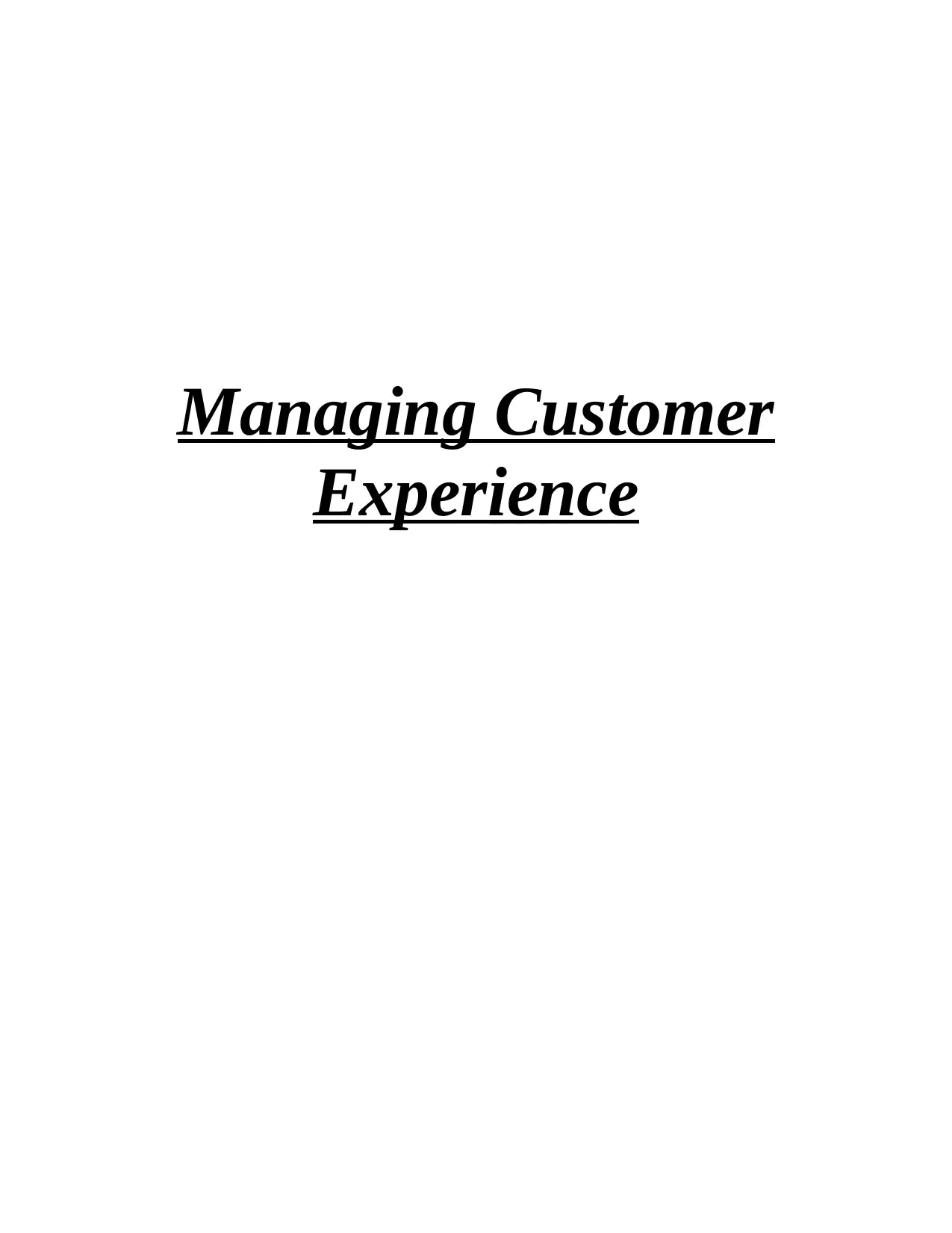
Managing Customer
Experience
Experience
Secure Best Marks with AI Grader
Need help grading? Try our AI Grader for instant feedback on your assignments.
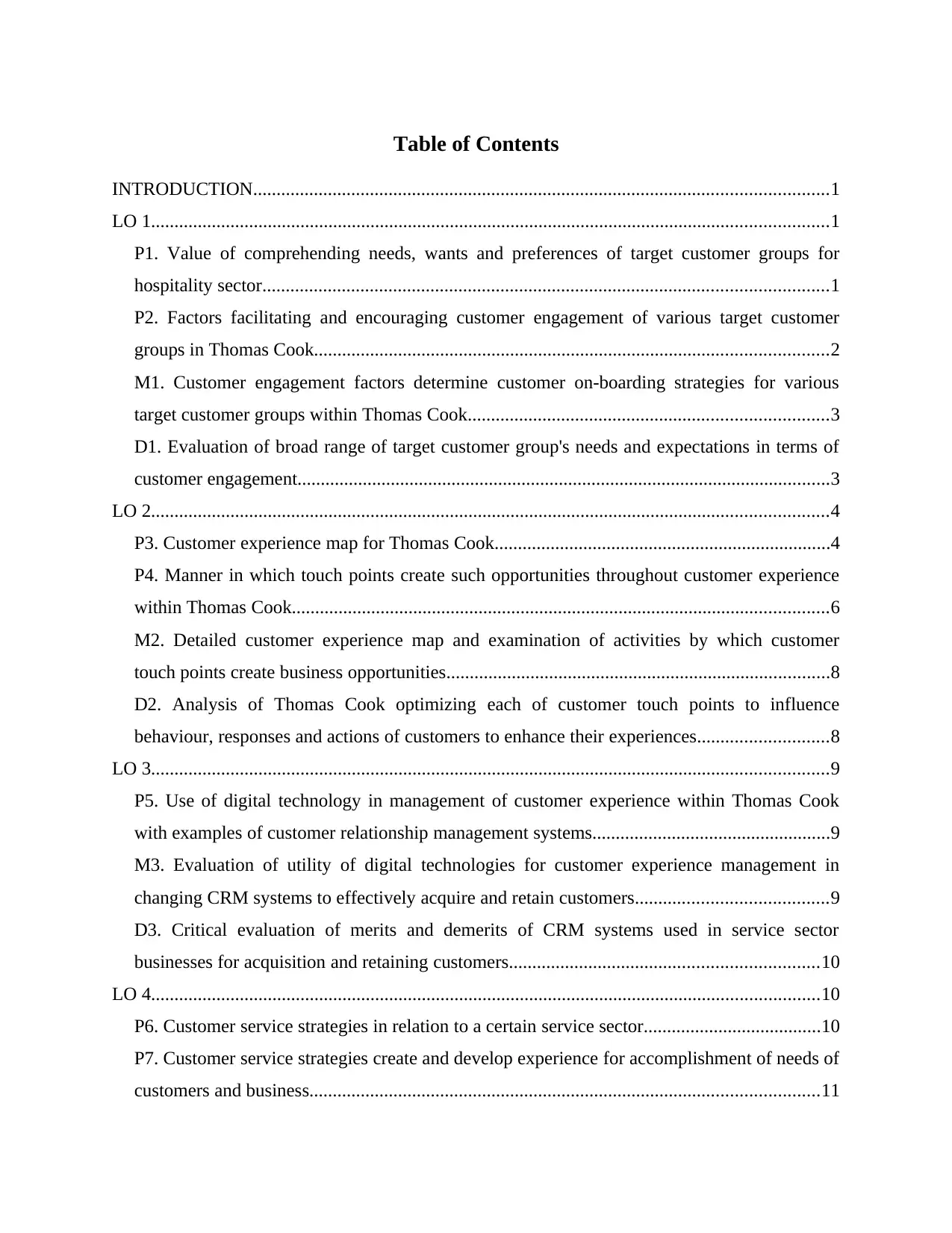
Table of Contents
INTRODUCTION...........................................................................................................................1
LO 1.................................................................................................................................................1
P1. Value of comprehending needs, wants and preferences of target customer groups for
hospitality sector.........................................................................................................................1
P2. Factors facilitating and encouraging customer engagement of various target customer
groups in Thomas Cook..............................................................................................................2
M1. Customer engagement factors determine customer on-boarding strategies for various
target customer groups within Thomas Cook.............................................................................3
D1. Evaluation of broad range of target customer group's needs and expectations in terms of
customer engagement..................................................................................................................3
LO 2.................................................................................................................................................4
P3. Customer experience map for Thomas Cook........................................................................4
P4. Manner in which touch points create such opportunities throughout customer experience
within Thomas Cook...................................................................................................................6
M2. Detailed customer experience map and examination of activities by which customer
touch points create business opportunities..................................................................................8
D2. Analysis of Thomas Cook optimizing each of customer touch points to influence
behaviour, responses and actions of customers to enhance their experiences............................8
LO 3.................................................................................................................................................9
P5. Use of digital technology in management of customer experience within Thomas Cook
with examples of customer relationship management systems...................................................9
M3. Evaluation of utility of digital technologies for customer experience management in
changing CRM systems to effectively acquire and retain customers.........................................9
D3. Critical evaluation of merits and demerits of CRM systems used in service sector
businesses for acquisition and retaining customers..................................................................10
LO 4...............................................................................................................................................10
P6. Customer service strategies in relation to a certain service sector......................................10
P7. Customer service strategies create and develop experience for accomplishment of needs of
customers and business.............................................................................................................11
INTRODUCTION...........................................................................................................................1
LO 1.................................................................................................................................................1
P1. Value of comprehending needs, wants and preferences of target customer groups for
hospitality sector.........................................................................................................................1
P2. Factors facilitating and encouraging customer engagement of various target customer
groups in Thomas Cook..............................................................................................................2
M1. Customer engagement factors determine customer on-boarding strategies for various
target customer groups within Thomas Cook.............................................................................3
D1. Evaluation of broad range of target customer group's needs and expectations in terms of
customer engagement..................................................................................................................3
LO 2.................................................................................................................................................4
P3. Customer experience map for Thomas Cook........................................................................4
P4. Manner in which touch points create such opportunities throughout customer experience
within Thomas Cook...................................................................................................................6
M2. Detailed customer experience map and examination of activities by which customer
touch points create business opportunities..................................................................................8
D2. Analysis of Thomas Cook optimizing each of customer touch points to influence
behaviour, responses and actions of customers to enhance their experiences............................8
LO 3.................................................................................................................................................9
P5. Use of digital technology in management of customer experience within Thomas Cook
with examples of customer relationship management systems...................................................9
M3. Evaluation of utility of digital technologies for customer experience management in
changing CRM systems to effectively acquire and retain customers.........................................9
D3. Critical evaluation of merits and demerits of CRM systems used in service sector
businesses for acquisition and retaining customers..................................................................10
LO 4...............................................................................................................................................10
P6. Customer service strategies in relation to a certain service sector......................................10
P7. Customer service strategies create and develop experience for accomplishment of needs of
customers and business.............................................................................................................11
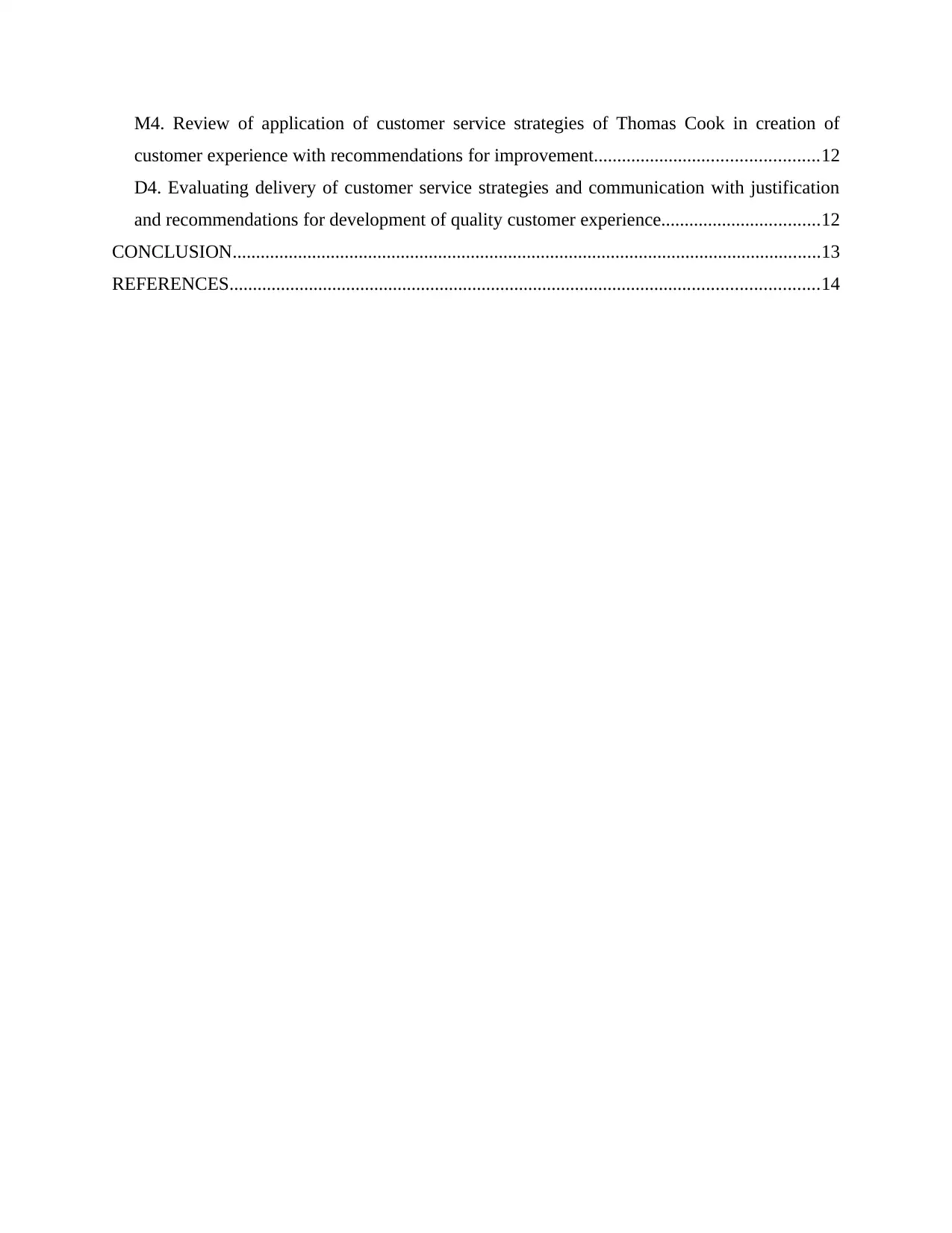
M4. Review of application of customer service strategies of Thomas Cook in creation of
customer experience with recommendations for improvement................................................12
D4. Evaluating delivery of customer service strategies and communication with justification
and recommendations for development of quality customer experience..................................12
CONCLUSION..............................................................................................................................13
REFERENCES..............................................................................................................................14
customer experience with recommendations for improvement................................................12
D4. Evaluating delivery of customer service strategies and communication with justification
and recommendations for development of quality customer experience..................................12
CONCLUSION..............................................................................................................................13
REFERENCES..............................................................................................................................14
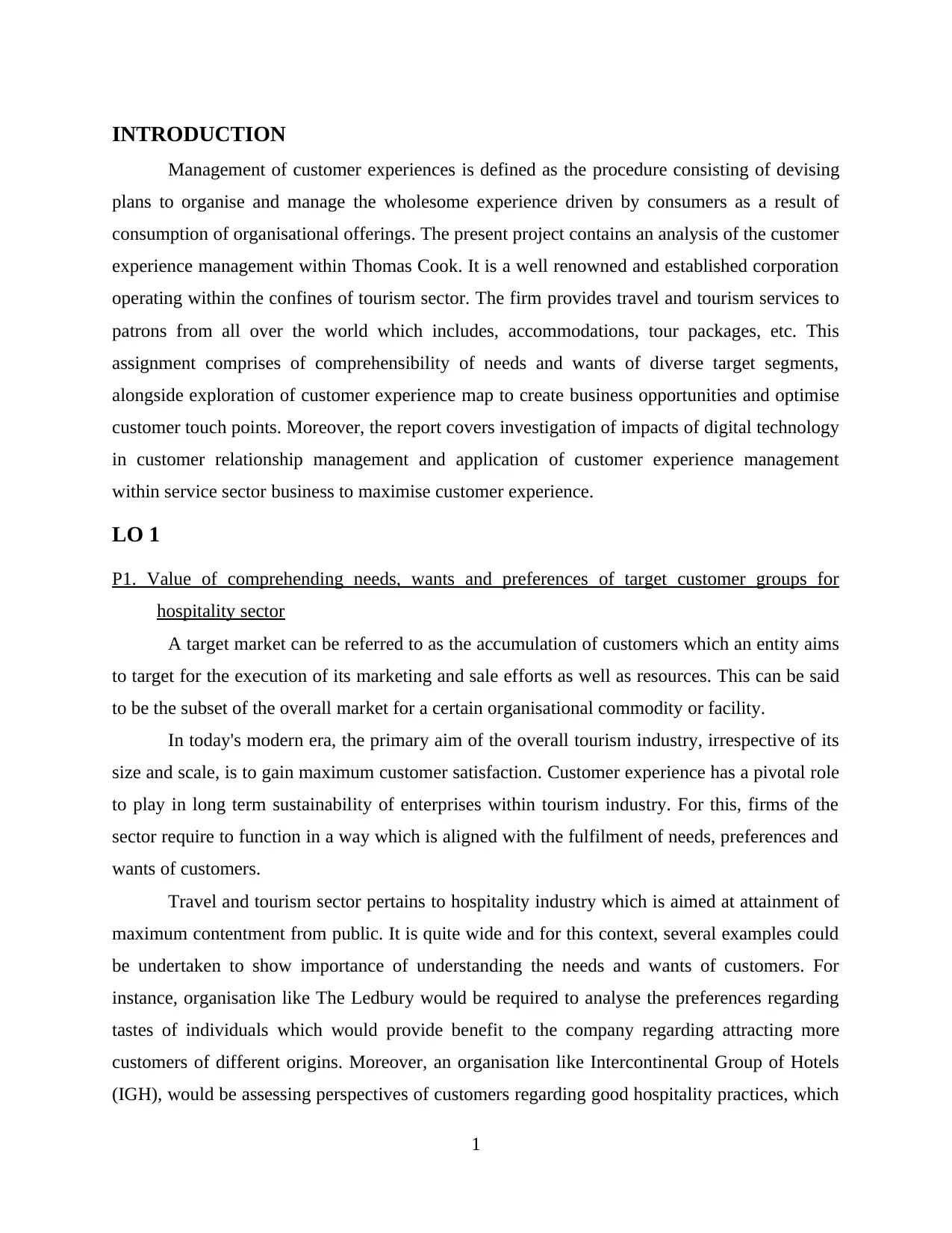
INTRODUCTION
Management of customer experiences is defined as the procedure consisting of devising
plans to organise and manage the wholesome experience driven by consumers as a result of
consumption of organisational offerings. The present project contains an analysis of the customer
experience management within Thomas Cook. It is a well renowned and established corporation
operating within the confines of tourism sector. The firm provides travel and tourism services to
patrons from all over the world which includes, accommodations, tour packages, etc. This
assignment comprises of comprehensibility of needs and wants of diverse target segments,
alongside exploration of customer experience map to create business opportunities and optimise
customer touch points. Moreover, the report covers investigation of impacts of digital technology
in customer relationship management and application of customer experience management
within service sector business to maximise customer experience.
LO 1
P1. Value of comprehending needs, wants and preferences of target customer groups for
hospitality sector
A target market can be referred to as the accumulation of customers which an entity aims
to target for the execution of its marketing and sale efforts as well as resources. This can be said
to be the subset of the overall market for a certain organisational commodity or facility.
In today's modern era, the primary aim of the overall tourism industry, irrespective of its
size and scale, is to gain maximum customer satisfaction. Customer experience has a pivotal role
to play in long term sustainability of enterprises within tourism industry. For this, firms of the
sector require to function in a way which is aligned with the fulfilment of needs, preferences and
wants of customers.
Travel and tourism sector pertains to hospitality industry which is aimed at attainment of
maximum contentment from public. It is quite wide and for this context, several examples could
be undertaken to show importance of understanding the needs and wants of customers. For
instance, organisation like The Ledbury would be required to analyse the preferences regarding
tastes of individuals which would provide benefit to the company regarding attracting more
customers of different origins. Moreover, an organisation like Intercontinental Group of Hotels
(IGH), would be assessing perspectives of customers regarding good hospitality practices, which
1
Management of customer experiences is defined as the procedure consisting of devising
plans to organise and manage the wholesome experience driven by consumers as a result of
consumption of organisational offerings. The present project contains an analysis of the customer
experience management within Thomas Cook. It is a well renowned and established corporation
operating within the confines of tourism sector. The firm provides travel and tourism services to
patrons from all over the world which includes, accommodations, tour packages, etc. This
assignment comprises of comprehensibility of needs and wants of diverse target segments,
alongside exploration of customer experience map to create business opportunities and optimise
customer touch points. Moreover, the report covers investigation of impacts of digital technology
in customer relationship management and application of customer experience management
within service sector business to maximise customer experience.
LO 1
P1. Value of comprehending needs, wants and preferences of target customer groups for
hospitality sector
A target market can be referred to as the accumulation of customers which an entity aims
to target for the execution of its marketing and sale efforts as well as resources. This can be said
to be the subset of the overall market for a certain organisational commodity or facility.
In today's modern era, the primary aim of the overall tourism industry, irrespective of its
size and scale, is to gain maximum customer satisfaction. Customer experience has a pivotal role
to play in long term sustainability of enterprises within tourism industry. For this, firms of the
sector require to function in a way which is aligned with the fulfilment of needs, preferences and
wants of customers.
Travel and tourism sector pertains to hospitality industry which is aimed at attainment of
maximum contentment from public. It is quite wide and for this context, several examples could
be undertaken to show importance of understanding the needs and wants of customers. For
instance, organisation like The Ledbury would be required to analyse the preferences regarding
tastes of individuals which would provide benefit to the company regarding attracting more
customers of different origins. Moreover, an organisation like Intercontinental Group of Hotels
(IGH), would be assessing perspectives of customers regarding good hospitality practices, which
1
Secure Best Marks with AI Grader
Need help grading? Try our AI Grader for instant feedback on your assignments.
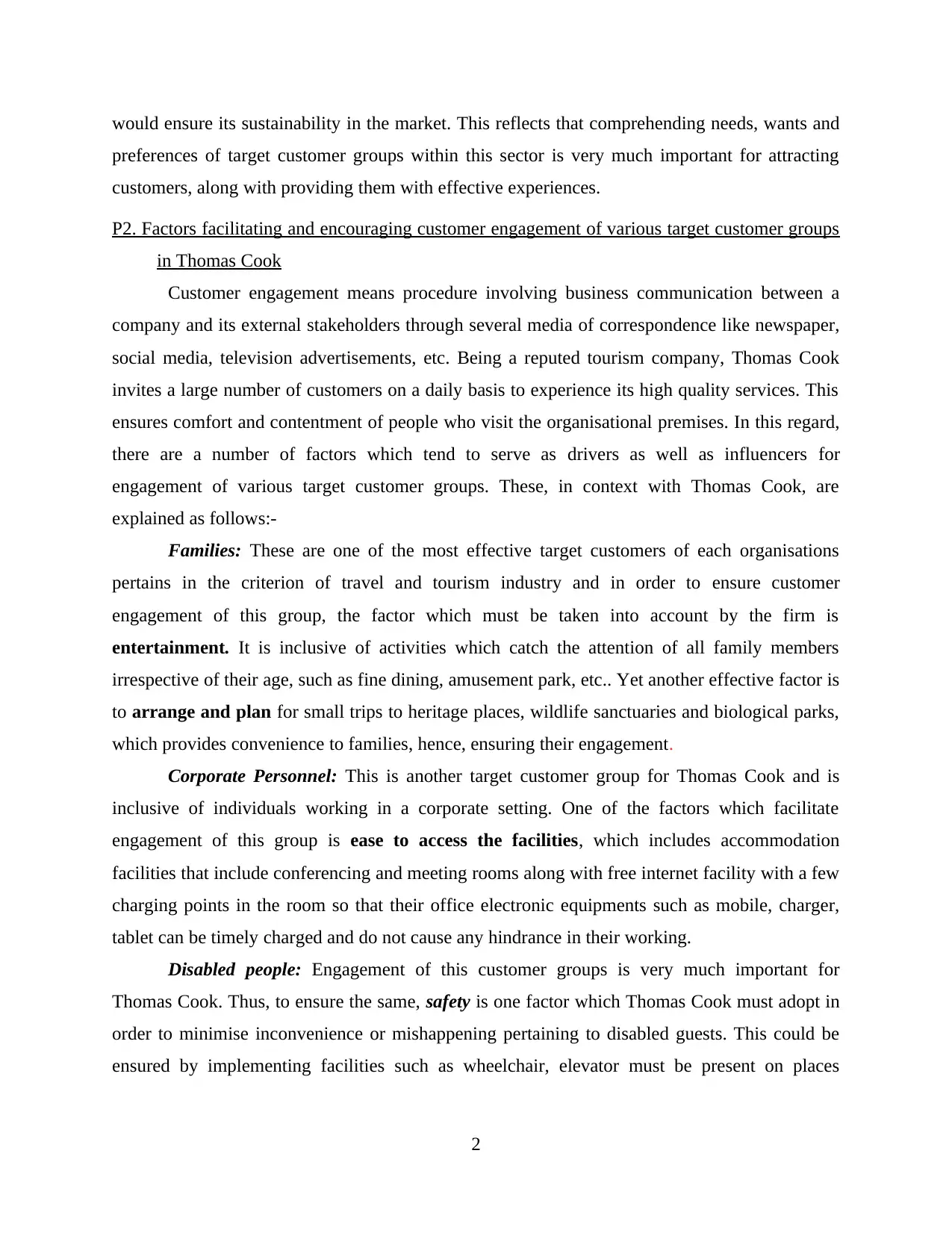
would ensure its sustainability in the market. This reflects that comprehending needs, wants and
preferences of target customer groups within this sector is very much important for attracting
customers, along with providing them with effective experiences.
P2. Factors facilitating and encouraging customer engagement of various target customer groups
in Thomas Cook
Customer engagement means procedure involving business communication between a
company and its external stakeholders through several media of correspondence like newspaper,
social media, television advertisements, etc. Being a reputed tourism company, Thomas Cook
invites a large number of customers on a daily basis to experience its high quality services. This
ensures comfort and contentment of people who visit the organisational premises. In this regard,
there are a number of factors which tend to serve as drivers as well as influencers for
engagement of various target customer groups. These, in context with Thomas Cook, are
explained as follows:-
Families: These are one of the most effective target customers of each organisations
pertains in the criterion of travel and tourism industry and in order to ensure customer
engagement of this group, the factor which must be taken into account by the firm is
entertainment. It is inclusive of activities which catch the attention of all family members
irrespective of their age, such as fine dining, amusement park, etc.. Yet another effective factor is
to arrange and plan for small trips to heritage places, wildlife sanctuaries and biological parks,
which provides convenience to families, hence, ensuring their engagement.
Corporate Personnel: This is another target customer group for Thomas Cook and is
inclusive of individuals working in a corporate setting. One of the factors which facilitate
engagement of this group is ease to access the facilities, which includes accommodation
facilities that include conferencing and meeting rooms along with free internet facility with a few
charging points in the room so that their office electronic equipments such as mobile, charger,
tablet can be timely charged and do not cause any hindrance in their working.
Disabled people: Engagement of this customer groups is very much important for
Thomas Cook. Thus, to ensure the same, safety is one factor which Thomas Cook must adopt in
order to minimise inconvenience or mishappening pertaining to disabled guests. This could be
ensured by implementing facilities such as wheelchair, elevator must be present on places
2
preferences of target customer groups within this sector is very much important for attracting
customers, along with providing them with effective experiences.
P2. Factors facilitating and encouraging customer engagement of various target customer groups
in Thomas Cook
Customer engagement means procedure involving business communication between a
company and its external stakeholders through several media of correspondence like newspaper,
social media, television advertisements, etc. Being a reputed tourism company, Thomas Cook
invites a large number of customers on a daily basis to experience its high quality services. This
ensures comfort and contentment of people who visit the organisational premises. In this regard,
there are a number of factors which tend to serve as drivers as well as influencers for
engagement of various target customer groups. These, in context with Thomas Cook, are
explained as follows:-
Families: These are one of the most effective target customers of each organisations
pertains in the criterion of travel and tourism industry and in order to ensure customer
engagement of this group, the factor which must be taken into account by the firm is
entertainment. It is inclusive of activities which catch the attention of all family members
irrespective of their age, such as fine dining, amusement park, etc.. Yet another effective factor is
to arrange and plan for small trips to heritage places, wildlife sanctuaries and biological parks,
which provides convenience to families, hence, ensuring their engagement.
Corporate Personnel: This is another target customer group for Thomas Cook and is
inclusive of individuals working in a corporate setting. One of the factors which facilitate
engagement of this group is ease to access the facilities, which includes accommodation
facilities that include conferencing and meeting rooms along with free internet facility with a few
charging points in the room so that their office electronic equipments such as mobile, charger,
tablet can be timely charged and do not cause any hindrance in their working.
Disabled people: Engagement of this customer groups is very much important for
Thomas Cook. Thus, to ensure the same, safety is one factor which Thomas Cook must adopt in
order to minimise inconvenience or mishappening pertaining to disabled guests. This could be
ensured by implementing facilities such as wheelchair, elevator must be present on places
2
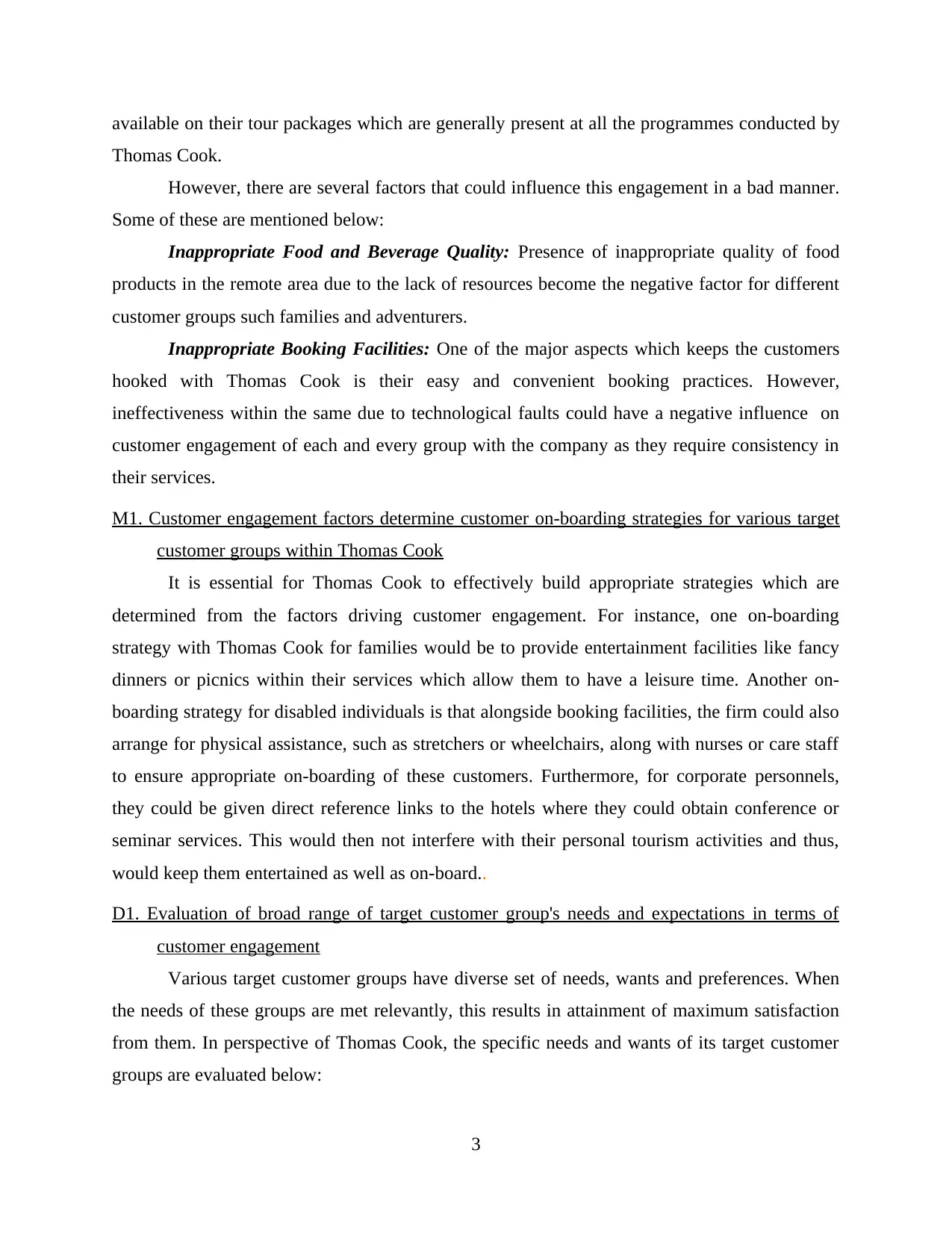
available on their tour packages which are generally present at all the programmes conducted by
Thomas Cook.
However, there are several factors that could influence this engagement in a bad manner.
Some of these are mentioned below:
Inappropriate Food and Beverage Quality: Presence of inappropriate quality of food
products in the remote area due to the lack of resources become the negative factor for different
customer groups such families and adventurers.
Inappropriate Booking Facilities: One of the major aspects which keeps the customers
hooked with Thomas Cook is their easy and convenient booking practices. However,
ineffectiveness within the same due to technological faults could have a negative influence on
customer engagement of each and every group with the company as they require consistency in
their services.
M1. Customer engagement factors determine customer on-boarding strategies for various target
customer groups within Thomas Cook
It is essential for Thomas Cook to effectively build appropriate strategies which are
determined from the factors driving customer engagement. For instance, one on-boarding
strategy with Thomas Cook for families would be to provide entertainment facilities like fancy
dinners or picnics within their services which allow them to have a leisure time. Another on-
boarding strategy for disabled individuals is that alongside booking facilities, the firm could also
arrange for physical assistance, such as stretchers or wheelchairs, along with nurses or care staff
to ensure appropriate on-boarding of these customers. Furthermore, for corporate personnels,
they could be given direct reference links to the hotels where they could obtain conference or
seminar services. This would then not interfere with their personal tourism activities and thus,
would keep them entertained as well as on-board..
D1. Evaluation of broad range of target customer group's needs and expectations in terms of
customer engagement
Various target customer groups have diverse set of needs, wants and preferences. When
the needs of these groups are met relevantly, this results in attainment of maximum satisfaction
from them. In perspective of Thomas Cook, the specific needs and wants of its target customer
groups are evaluated below:
3
Thomas Cook.
However, there are several factors that could influence this engagement in a bad manner.
Some of these are mentioned below:
Inappropriate Food and Beverage Quality: Presence of inappropriate quality of food
products in the remote area due to the lack of resources become the negative factor for different
customer groups such families and adventurers.
Inappropriate Booking Facilities: One of the major aspects which keeps the customers
hooked with Thomas Cook is their easy and convenient booking practices. However,
ineffectiveness within the same due to technological faults could have a negative influence on
customer engagement of each and every group with the company as they require consistency in
their services.
M1. Customer engagement factors determine customer on-boarding strategies for various target
customer groups within Thomas Cook
It is essential for Thomas Cook to effectively build appropriate strategies which are
determined from the factors driving customer engagement. For instance, one on-boarding
strategy with Thomas Cook for families would be to provide entertainment facilities like fancy
dinners or picnics within their services which allow them to have a leisure time. Another on-
boarding strategy for disabled individuals is that alongside booking facilities, the firm could also
arrange for physical assistance, such as stretchers or wheelchairs, along with nurses or care staff
to ensure appropriate on-boarding of these customers. Furthermore, for corporate personnels,
they could be given direct reference links to the hotels where they could obtain conference or
seminar services. This would then not interfere with their personal tourism activities and thus,
would keep them entertained as well as on-board..
D1. Evaluation of broad range of target customer group's needs and expectations in terms of
customer engagement
Various target customer groups have diverse set of needs, wants and preferences. When
the needs of these groups are met relevantly, this results in attainment of maximum satisfaction
from them. In perspective of Thomas Cook, the specific needs and wants of its target customer
groups are evaluated below:
3
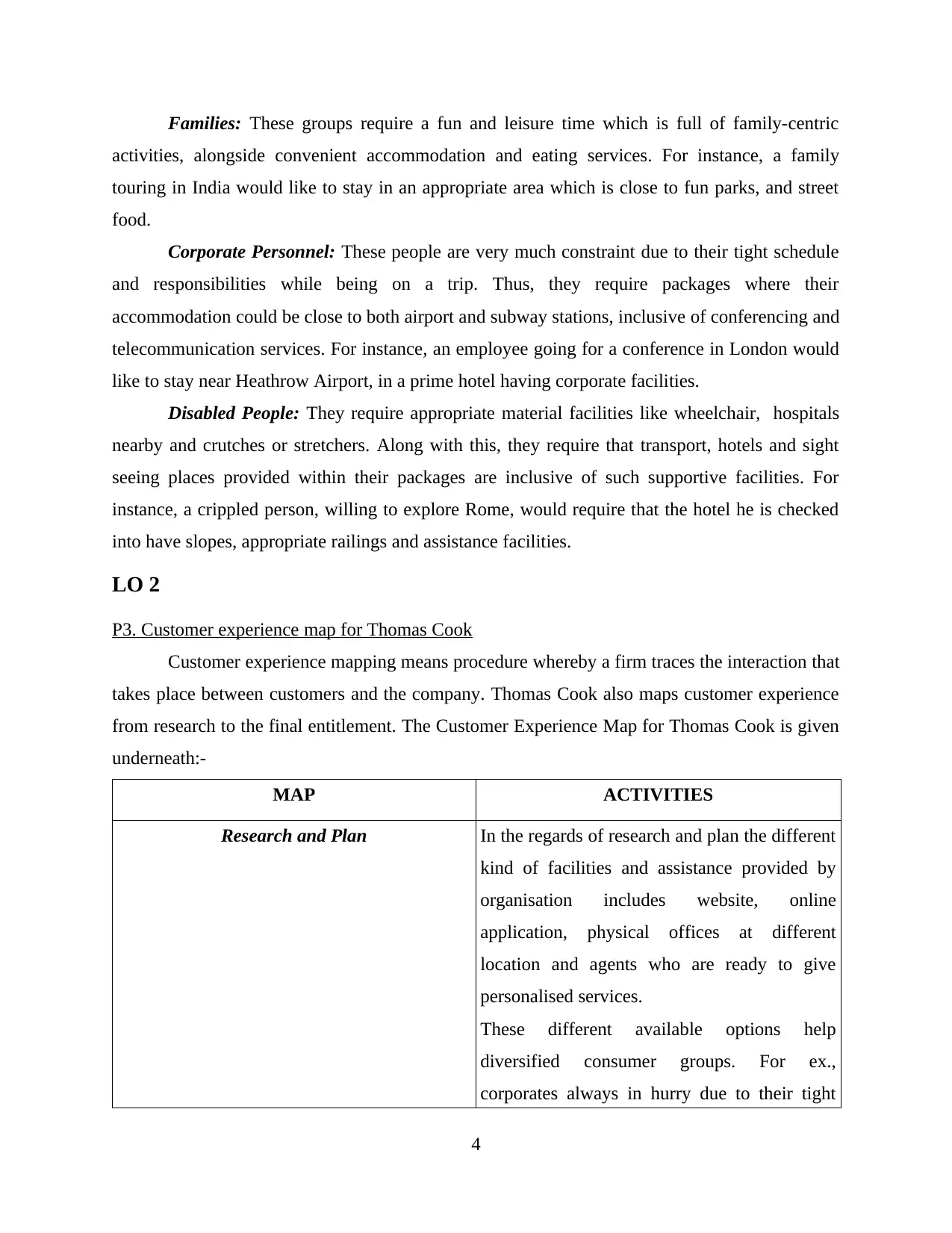
Families: These groups require a fun and leisure time which is full of family-centric
activities, alongside convenient accommodation and eating services. For instance, a family
touring in India would like to stay in an appropriate area which is close to fun parks, and street
food.
Corporate Personnel: These people are very much constraint due to their tight schedule
and responsibilities while being on a trip. Thus, they require packages where their
accommodation could be close to both airport and subway stations, inclusive of conferencing and
telecommunication services. For instance, an employee going for a conference in London would
like to stay near Heathrow Airport, in a prime hotel having corporate facilities.
Disabled People: They require appropriate material facilities like wheelchair, hospitals
nearby and crutches or stretchers. Along with this, they require that transport, hotels and sight
seeing places provided within their packages are inclusive of such supportive facilities. For
instance, a crippled person, willing to explore Rome, would require that the hotel he is checked
into have slopes, appropriate railings and assistance facilities.
LO 2
P3. Customer experience map for Thomas Cook
Customer experience mapping means procedure whereby a firm traces the interaction that
takes place between customers and the company. Thomas Cook also maps customer experience
from research to the final entitlement. The Customer Experience Map for Thomas Cook is given
underneath:-
MAP ACTIVITIES
Research and Plan In the regards of research and plan the different
kind of facilities and assistance provided by
organisation includes website, online
application, physical offices at different
location and agents who are ready to give
personalised services.
These different available options help
diversified consumer groups. For ex.,
corporates always in hurry due to their tight
4
activities, alongside convenient accommodation and eating services. For instance, a family
touring in India would like to stay in an appropriate area which is close to fun parks, and street
food.
Corporate Personnel: These people are very much constraint due to their tight schedule
and responsibilities while being on a trip. Thus, they require packages where their
accommodation could be close to both airport and subway stations, inclusive of conferencing and
telecommunication services. For instance, an employee going for a conference in London would
like to stay near Heathrow Airport, in a prime hotel having corporate facilities.
Disabled People: They require appropriate material facilities like wheelchair, hospitals
nearby and crutches or stretchers. Along with this, they require that transport, hotels and sight
seeing places provided within their packages are inclusive of such supportive facilities. For
instance, a crippled person, willing to explore Rome, would require that the hotel he is checked
into have slopes, appropriate railings and assistance facilities.
LO 2
P3. Customer experience map for Thomas Cook
Customer experience mapping means procedure whereby a firm traces the interaction that
takes place between customers and the company. Thomas Cook also maps customer experience
from research to the final entitlement. The Customer Experience Map for Thomas Cook is given
underneath:-
MAP ACTIVITIES
Research and Plan In the regards of research and plan the different
kind of facilities and assistance provided by
organisation includes website, online
application, physical offices at different
location and agents who are ready to give
personalised services.
These different available options help
diversified consumer groups. For ex.,
corporates always in hurry due to their tight
4
Paraphrase This Document
Need a fresh take? Get an instant paraphrase of this document with our AI Paraphraser
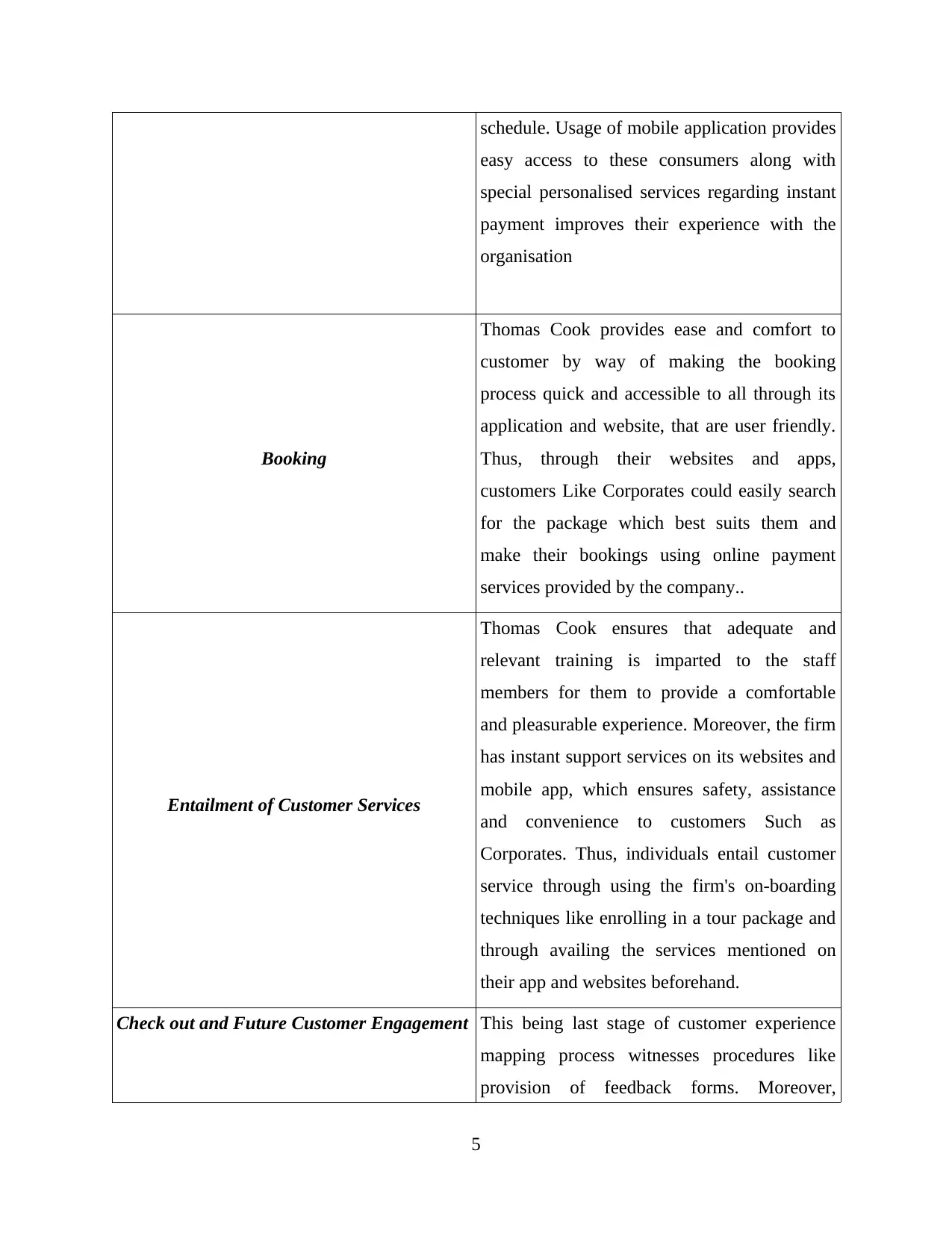
schedule. Usage of mobile application provides
easy access to these consumers along with
special personalised services regarding instant
payment improves their experience with the
organisation
Booking
Thomas Cook provides ease and comfort to
customer by way of making the booking
process quick and accessible to all through its
application and website, that are user friendly.
Thus, through their websites and apps,
customers Like Corporates could easily search
for the package which best suits them and
make their bookings using online payment
services provided by the company..
Entailment of Customer Services
Thomas Cook ensures that adequate and
relevant training is imparted to the staff
members for them to provide a comfortable
and pleasurable experience. Moreover, the firm
has instant support services on its websites and
mobile app, which ensures safety, assistance
and convenience to customers Such as
Corporates. Thus, individuals entail customer
service through using the firm's on-boarding
techniques like enrolling in a tour package and
through availing the services mentioned on
their app and websites beforehand.
Check out and Future Customer Engagement This being last stage of customer experience
mapping process witnesses procedures like
provision of feedback forms. Moreover,
5
easy access to these consumers along with
special personalised services regarding instant
payment improves their experience with the
organisation
Booking
Thomas Cook provides ease and comfort to
customer by way of making the booking
process quick and accessible to all through its
application and website, that are user friendly.
Thus, through their websites and apps,
customers Like Corporates could easily search
for the package which best suits them and
make their bookings using online payment
services provided by the company..
Entailment of Customer Services
Thomas Cook ensures that adequate and
relevant training is imparted to the staff
members for them to provide a comfortable
and pleasurable experience. Moreover, the firm
has instant support services on its websites and
mobile app, which ensures safety, assistance
and convenience to customers Such as
Corporates. Thus, individuals entail customer
service through using the firm's on-boarding
techniques like enrolling in a tour package and
through availing the services mentioned on
their app and websites beforehand.
Check out and Future Customer Engagement This being last stage of customer experience
mapping process witnesses procedures like
provision of feedback forms. Moreover,
5
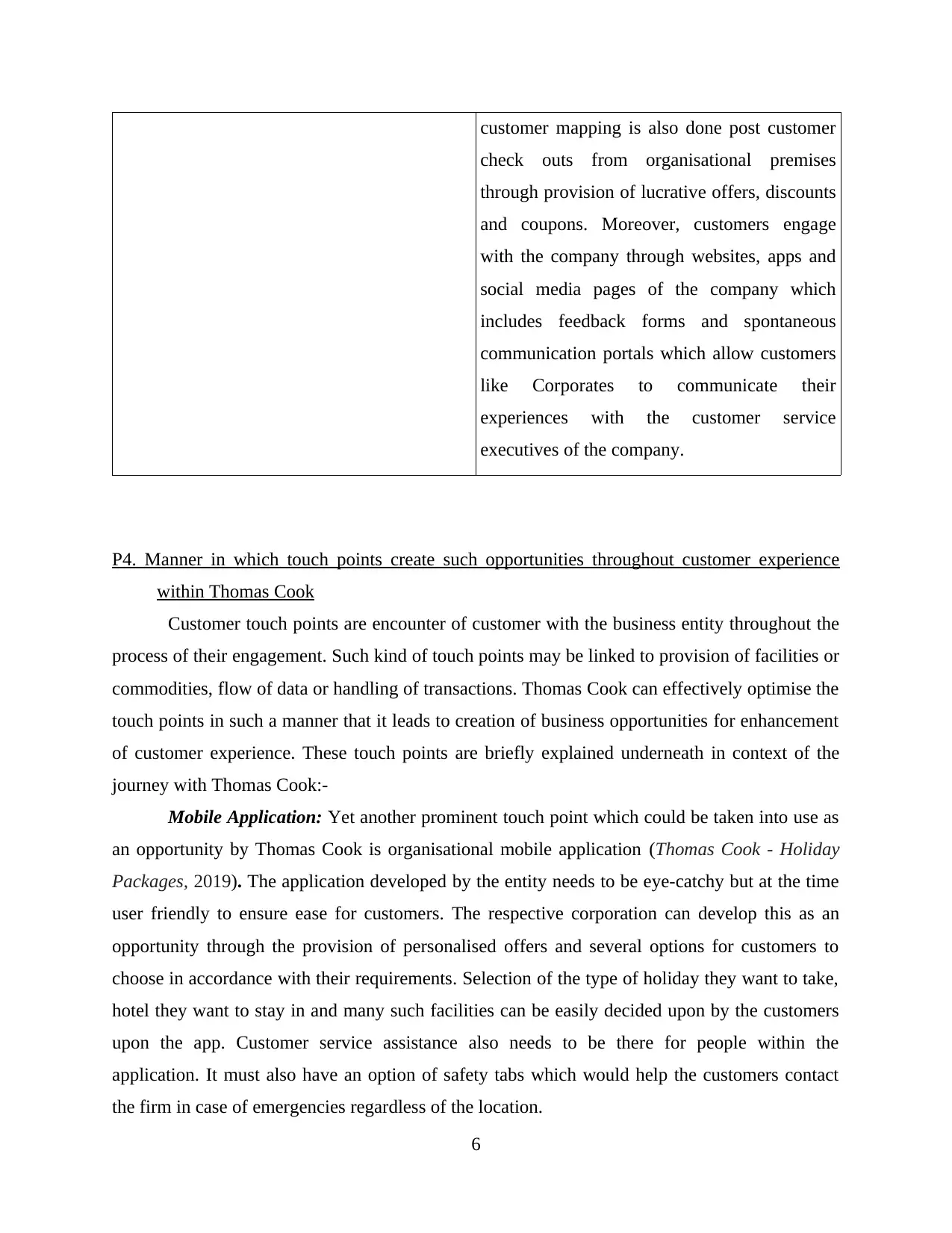
customer mapping is also done post customer
check outs from organisational premises
through provision of lucrative offers, discounts
and coupons. Moreover, customers engage
with the company through websites, apps and
social media pages of the company which
includes feedback forms and spontaneous
communication portals which allow customers
like Corporates to communicate their
experiences with the customer service
executives of the company.
P4. Manner in which touch points create such opportunities throughout customer experience
within Thomas Cook
Customer touch points are encounter of customer with the business entity throughout the
process of their engagement. Such kind of touch points may be linked to provision of facilities or
commodities, flow of data or handling of transactions. Thomas Cook can effectively optimise the
touch points in such a manner that it leads to creation of business opportunities for enhancement
of customer experience. These touch points are briefly explained underneath in context of the
journey with Thomas Cook:-
Mobile Application: Yet another prominent touch point which could be taken into use as
an opportunity by Thomas Cook is organisational mobile application (Thomas Cook - Holiday
Packages, 2019). The application developed by the entity needs to be eye-catchy but at the time
user friendly to ensure ease for customers. The respective corporation can develop this as an
opportunity through the provision of personalised offers and several options for customers to
choose in accordance with their requirements. Selection of the type of holiday they want to take,
hotel they want to stay in and many such facilities can be easily decided upon by the customers
upon the app. Customer service assistance also needs to be there for people within the
application. It must also have an option of safety tabs which would help the customers contact
the firm in case of emergencies regardless of the location.
6
check outs from organisational premises
through provision of lucrative offers, discounts
and coupons. Moreover, customers engage
with the company through websites, apps and
social media pages of the company which
includes feedback forms and spontaneous
communication portals which allow customers
like Corporates to communicate their
experiences with the customer service
executives of the company.
P4. Manner in which touch points create such opportunities throughout customer experience
within Thomas Cook
Customer touch points are encounter of customer with the business entity throughout the
process of their engagement. Such kind of touch points may be linked to provision of facilities or
commodities, flow of data or handling of transactions. Thomas Cook can effectively optimise the
touch points in such a manner that it leads to creation of business opportunities for enhancement
of customer experience. These touch points are briefly explained underneath in context of the
journey with Thomas Cook:-
Mobile Application: Yet another prominent touch point which could be taken into use as
an opportunity by Thomas Cook is organisational mobile application (Thomas Cook - Holiday
Packages, 2019). The application developed by the entity needs to be eye-catchy but at the time
user friendly to ensure ease for customers. The respective corporation can develop this as an
opportunity through the provision of personalised offers and several options for customers to
choose in accordance with their requirements. Selection of the type of holiday they want to take,
hotel they want to stay in and many such facilities can be easily decided upon by the customers
upon the app. Customer service assistance also needs to be there for people within the
application. It must also have an option of safety tabs which would help the customers contact
the firm in case of emergencies regardless of the location.
6
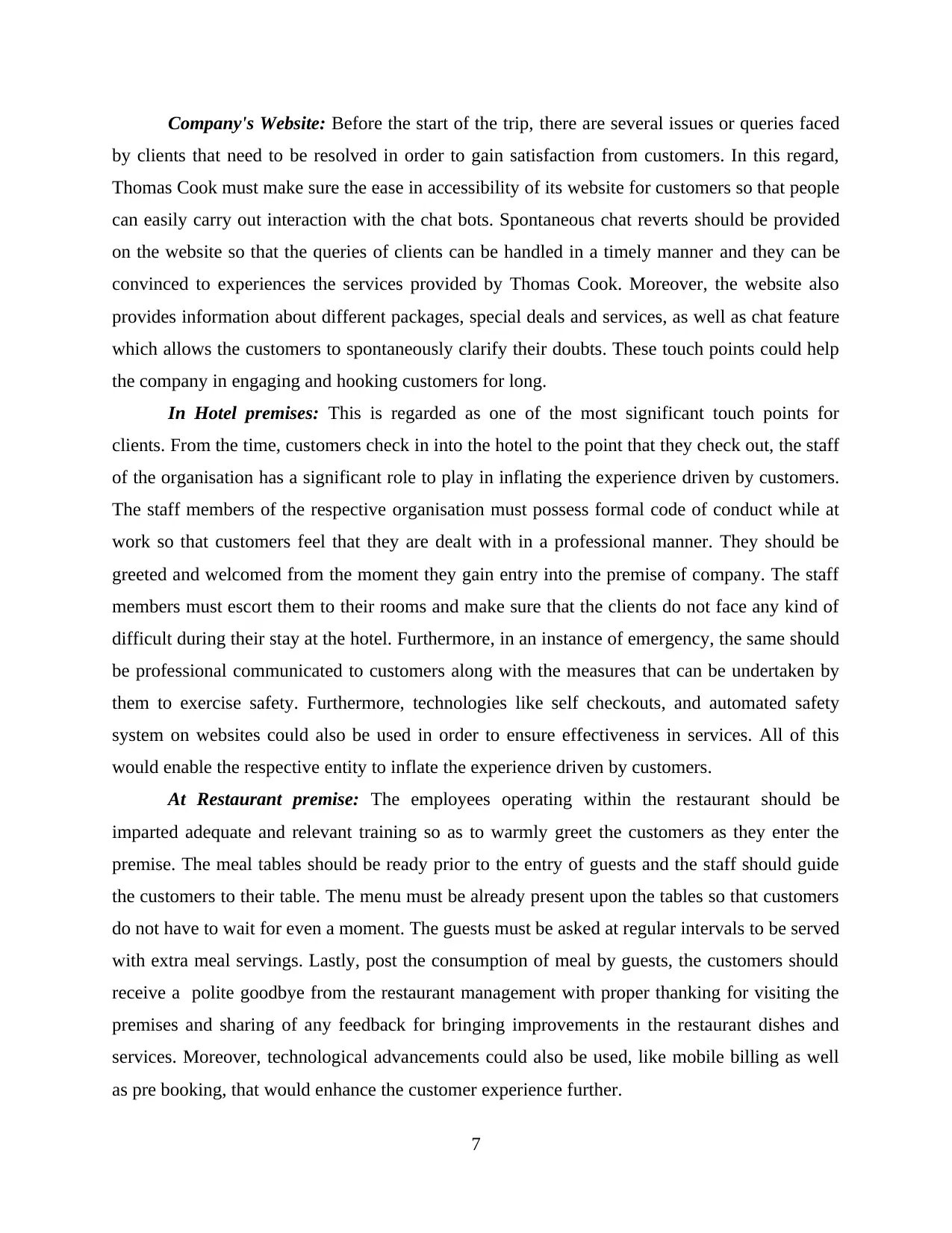
Company's Website: Before the start of the trip, there are several issues or queries faced
by clients that need to be resolved in order to gain satisfaction from customers. In this regard,
Thomas Cook must make sure the ease in accessibility of its website for customers so that people
can easily carry out interaction with the chat bots. Spontaneous chat reverts should be provided
on the website so that the queries of clients can be handled in a timely manner and they can be
convinced to experiences the services provided by Thomas Cook. Moreover, the website also
provides information about different packages, special deals and services, as well as chat feature
which allows the customers to spontaneously clarify their doubts. These touch points could help
the company in engaging and hooking customers for long.
In Hotel premises: This is regarded as one of the most significant touch points for
clients. From the time, customers check in into the hotel to the point that they check out, the staff
of the organisation has a significant role to play in inflating the experience driven by customers.
The staff members of the respective organisation must possess formal code of conduct while at
work so that customers feel that they are dealt with in a professional manner. They should be
greeted and welcomed from the moment they gain entry into the premise of company. The staff
members must escort them to their rooms and make sure that the clients do not face any kind of
difficult during their stay at the hotel. Furthermore, in an instance of emergency, the same should
be professional communicated to customers along with the measures that can be undertaken by
them to exercise safety. Furthermore, technologies like self checkouts, and automated safety
system on websites could also be used in order to ensure effectiveness in services. All of this
would enable the respective entity to inflate the experience driven by customers.
At Restaurant premise: The employees operating within the restaurant should be
imparted adequate and relevant training so as to warmly greet the customers as they enter the
premise. The meal tables should be ready prior to the entry of guests and the staff should guide
the customers to their table. The menu must be already present upon the tables so that customers
do not have to wait for even a moment. The guests must be asked at regular intervals to be served
with extra meal servings. Lastly, post the consumption of meal by guests, the customers should
receive a polite goodbye from the restaurant management with proper thanking for visiting the
premises and sharing of any feedback for bringing improvements in the restaurant dishes and
services. Moreover, technological advancements could also be used, like mobile billing as well
as pre booking, that would enhance the customer experience further.
7
by clients that need to be resolved in order to gain satisfaction from customers. In this regard,
Thomas Cook must make sure the ease in accessibility of its website for customers so that people
can easily carry out interaction with the chat bots. Spontaneous chat reverts should be provided
on the website so that the queries of clients can be handled in a timely manner and they can be
convinced to experiences the services provided by Thomas Cook. Moreover, the website also
provides information about different packages, special deals and services, as well as chat feature
which allows the customers to spontaneously clarify their doubts. These touch points could help
the company in engaging and hooking customers for long.
In Hotel premises: This is regarded as one of the most significant touch points for
clients. From the time, customers check in into the hotel to the point that they check out, the staff
of the organisation has a significant role to play in inflating the experience driven by customers.
The staff members of the respective organisation must possess formal code of conduct while at
work so that customers feel that they are dealt with in a professional manner. They should be
greeted and welcomed from the moment they gain entry into the premise of company. The staff
members must escort them to their rooms and make sure that the clients do not face any kind of
difficult during their stay at the hotel. Furthermore, in an instance of emergency, the same should
be professional communicated to customers along with the measures that can be undertaken by
them to exercise safety. Furthermore, technologies like self checkouts, and automated safety
system on websites could also be used in order to ensure effectiveness in services. All of this
would enable the respective entity to inflate the experience driven by customers.
At Restaurant premise: The employees operating within the restaurant should be
imparted adequate and relevant training so as to warmly greet the customers as they enter the
premise. The meal tables should be ready prior to the entry of guests and the staff should guide
the customers to their table. The menu must be already present upon the tables so that customers
do not have to wait for even a moment. The guests must be asked at regular intervals to be served
with extra meal servings. Lastly, post the consumption of meal by guests, the customers should
receive a polite goodbye from the restaurant management with proper thanking for visiting the
premises and sharing of any feedback for bringing improvements in the restaurant dishes and
services. Moreover, technological advancements could also be used, like mobile billing as well
as pre booking, that would enhance the customer experience further.
7
Secure Best Marks with AI Grader
Need help grading? Try our AI Grader for instant feedback on your assignments.
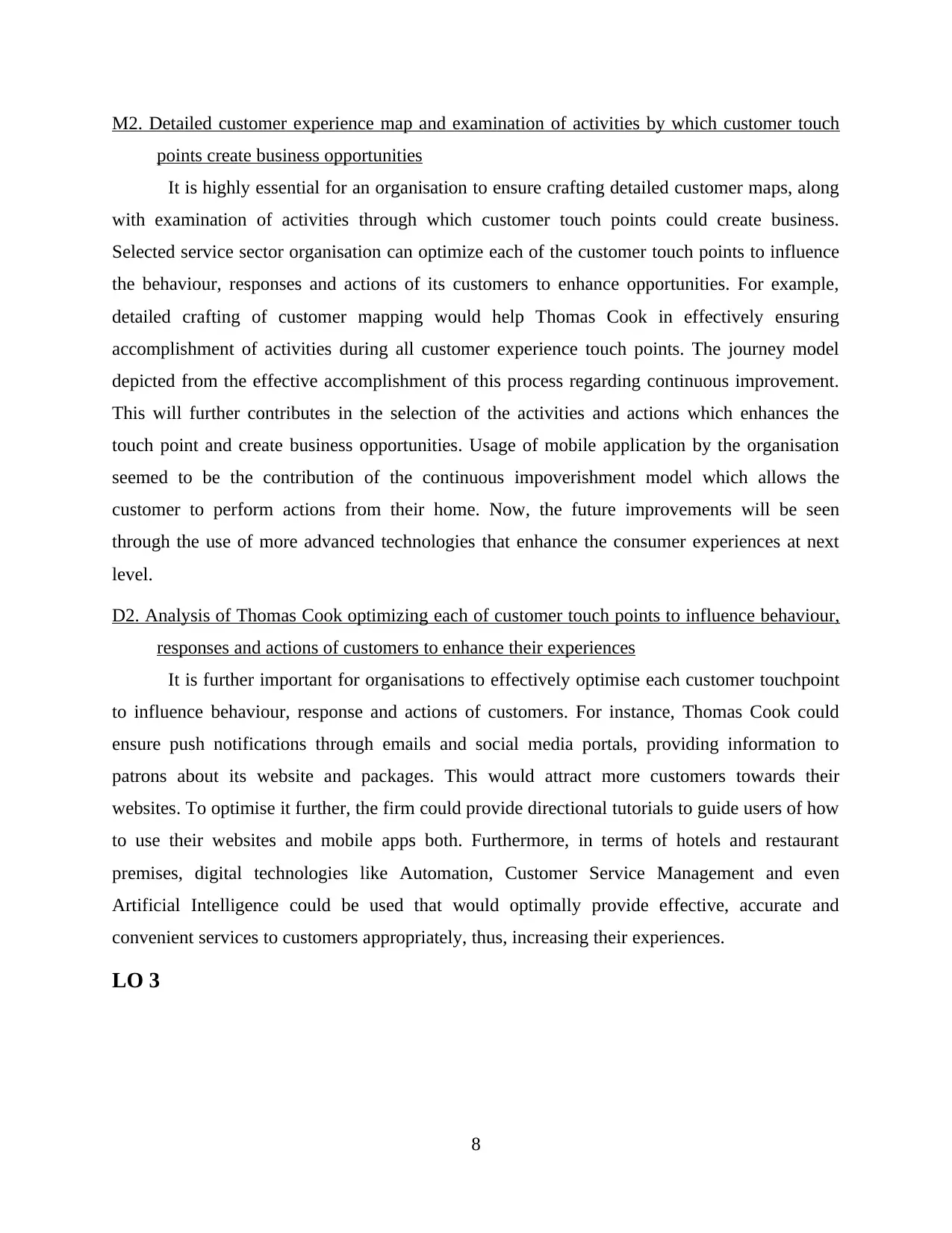
M2. Detailed customer experience map and examination of activities by which customer touch
points create business opportunities
It is highly essential for an organisation to ensure crafting detailed customer maps, along
with examination of activities through which customer touch points could create business.
Selected service sector organisation can optimize each of the customer touch points to influence
the behaviour, responses and actions of its customers to enhance opportunities. For example,
detailed crafting of customer mapping would help Thomas Cook in effectively ensuring
accomplishment of activities during all customer experience touch points. The journey model
depicted from the effective accomplishment of this process regarding continuous improvement.
This will further contributes in the selection of the activities and actions which enhances the
touch point and create business opportunities. Usage of mobile application by the organisation
seemed to be the contribution of the continuous impoverishment model which allows the
customer to perform actions from their home. Now, the future improvements will be seen
through the use of more advanced technologies that enhance the consumer experiences at next
level.
D2. Analysis of Thomas Cook optimizing each of customer touch points to influence behaviour,
responses and actions of customers to enhance their experiences
It is further important for organisations to effectively optimise each customer touchpoint
to influence behaviour, response and actions of customers. For instance, Thomas Cook could
ensure push notifications through emails and social media portals, providing information to
patrons about its website and packages. This would attract more customers towards their
websites. To optimise it further, the firm could provide directional tutorials to guide users of how
to use their websites and mobile apps both. Furthermore, in terms of hotels and restaurant
premises, digital technologies like Automation, Customer Service Management and even
Artificial Intelligence could be used that would optimally provide effective, accurate and
convenient services to customers appropriately, thus, increasing their experiences.
LO 3
8
points create business opportunities
It is highly essential for an organisation to ensure crafting detailed customer maps, along
with examination of activities through which customer touch points could create business.
Selected service sector organisation can optimize each of the customer touch points to influence
the behaviour, responses and actions of its customers to enhance opportunities. For example,
detailed crafting of customer mapping would help Thomas Cook in effectively ensuring
accomplishment of activities during all customer experience touch points. The journey model
depicted from the effective accomplishment of this process regarding continuous improvement.
This will further contributes in the selection of the activities and actions which enhances the
touch point and create business opportunities. Usage of mobile application by the organisation
seemed to be the contribution of the continuous impoverishment model which allows the
customer to perform actions from their home. Now, the future improvements will be seen
through the use of more advanced technologies that enhance the consumer experiences at next
level.
D2. Analysis of Thomas Cook optimizing each of customer touch points to influence behaviour,
responses and actions of customers to enhance their experiences
It is further important for organisations to effectively optimise each customer touchpoint
to influence behaviour, response and actions of customers. For instance, Thomas Cook could
ensure push notifications through emails and social media portals, providing information to
patrons about its website and packages. This would attract more customers towards their
websites. To optimise it further, the firm could provide directional tutorials to guide users of how
to use their websites and mobile apps both. Furthermore, in terms of hotels and restaurant
premises, digital technologies like Automation, Customer Service Management and even
Artificial Intelligence could be used that would optimally provide effective, accurate and
convenient services to customers appropriately, thus, increasing their experiences.
LO 3
8
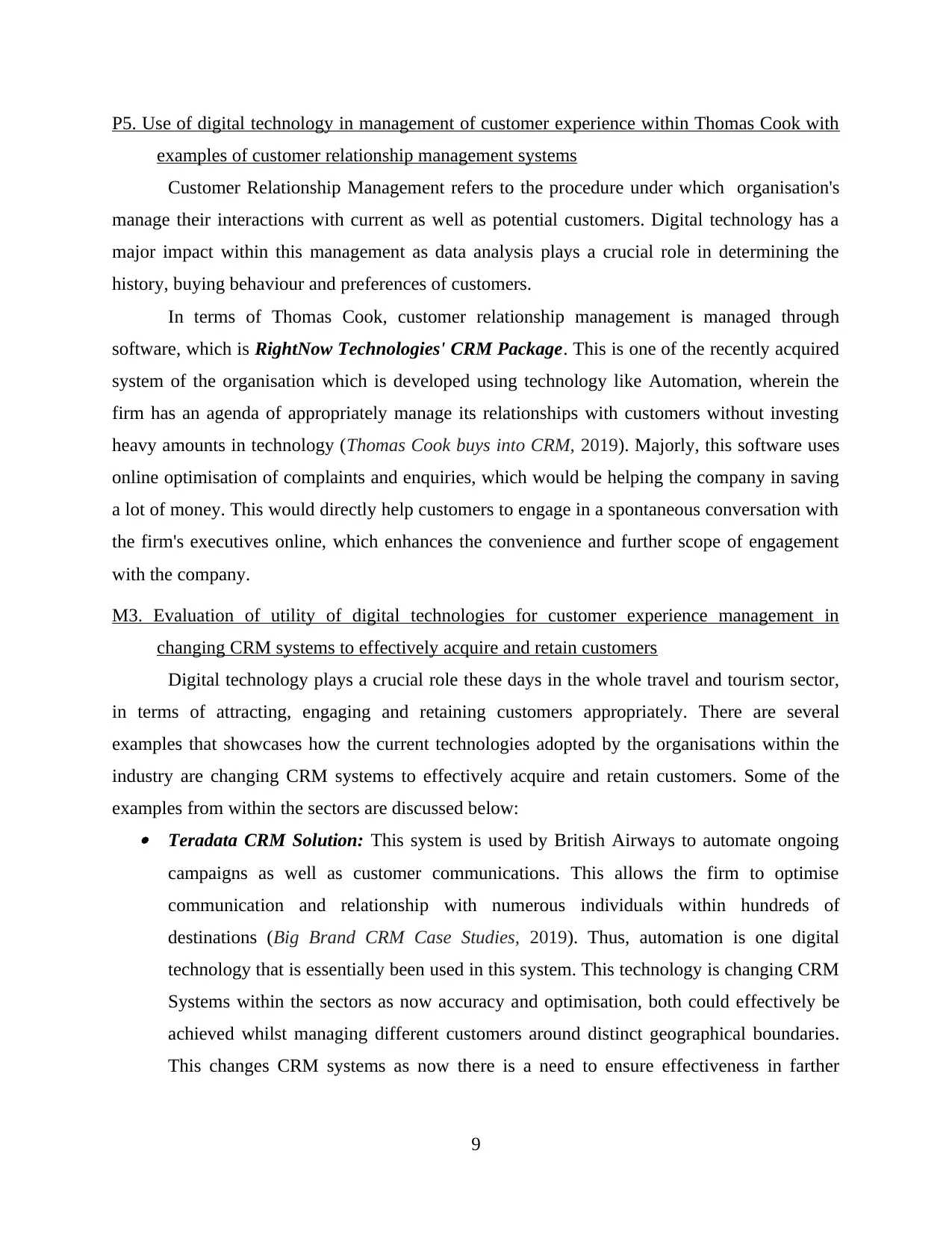
P5. Use of digital technology in management of customer experience within Thomas Cook with
examples of customer relationship management systems
Customer Relationship Management refers to the procedure under which organisation's
manage their interactions with current as well as potential customers. Digital technology has a
major impact within this management as data analysis plays a crucial role in determining the
history, buying behaviour and preferences of customers.
In terms of Thomas Cook, customer relationship management is managed through
software, which is RightNow Technologies' CRM Package. This is one of the recently acquired
system of the organisation which is developed using technology like Automation, wherein the
firm has an agenda of appropriately manage its relationships with customers without investing
heavy amounts in technology (Thomas Cook buys into CRM, 2019). Majorly, this software uses
online optimisation of complaints and enquiries, which would be helping the company in saving
a lot of money. This would directly help customers to engage in a spontaneous conversation with
the firm's executives online, which enhances the convenience and further scope of engagement
with the company.
M3. Evaluation of utility of digital technologies for customer experience management in
changing CRM systems to effectively acquire and retain customers
Digital technology plays a crucial role these days in the whole travel and tourism sector,
in terms of attracting, engaging and retaining customers appropriately. There are several
examples that showcases how the current technologies adopted by the organisations within the
industry are changing CRM systems to effectively acquire and retain customers. Some of the
examples from within the sectors are discussed below: Teradata CRM Solution: This system is used by British Airways to automate ongoing
campaigns as well as customer communications. This allows the firm to optimise
communication and relationship with numerous individuals within hundreds of
destinations (Big Brand CRM Case Studies, 2019). Thus, automation is one digital
technology that is essentially been used in this system. This technology is changing CRM
Systems within the sectors as now accuracy and optimisation, both could effectively be
achieved whilst managing different customers around distinct geographical boundaries.
This changes CRM systems as now there is a need to ensure effectiveness in farther
9
examples of customer relationship management systems
Customer Relationship Management refers to the procedure under which organisation's
manage their interactions with current as well as potential customers. Digital technology has a
major impact within this management as data analysis plays a crucial role in determining the
history, buying behaviour and preferences of customers.
In terms of Thomas Cook, customer relationship management is managed through
software, which is RightNow Technologies' CRM Package. This is one of the recently acquired
system of the organisation which is developed using technology like Automation, wherein the
firm has an agenda of appropriately manage its relationships with customers without investing
heavy amounts in technology (Thomas Cook buys into CRM, 2019). Majorly, this software uses
online optimisation of complaints and enquiries, which would be helping the company in saving
a lot of money. This would directly help customers to engage in a spontaneous conversation with
the firm's executives online, which enhances the convenience and further scope of engagement
with the company.
M3. Evaluation of utility of digital technologies for customer experience management in
changing CRM systems to effectively acquire and retain customers
Digital technology plays a crucial role these days in the whole travel and tourism sector,
in terms of attracting, engaging and retaining customers appropriately. There are several
examples that showcases how the current technologies adopted by the organisations within the
industry are changing CRM systems to effectively acquire and retain customers. Some of the
examples from within the sectors are discussed below: Teradata CRM Solution: This system is used by British Airways to automate ongoing
campaigns as well as customer communications. This allows the firm to optimise
communication and relationship with numerous individuals within hundreds of
destinations (Big Brand CRM Case Studies, 2019). Thus, automation is one digital
technology that is essentially been used in this system. This technology is changing CRM
Systems within the sectors as now accuracy and optimisation, both could effectively be
achieved whilst managing different customers around distinct geographical boundaries.
This changes CRM systems as now there is a need to ensure effectiveness in farther
9
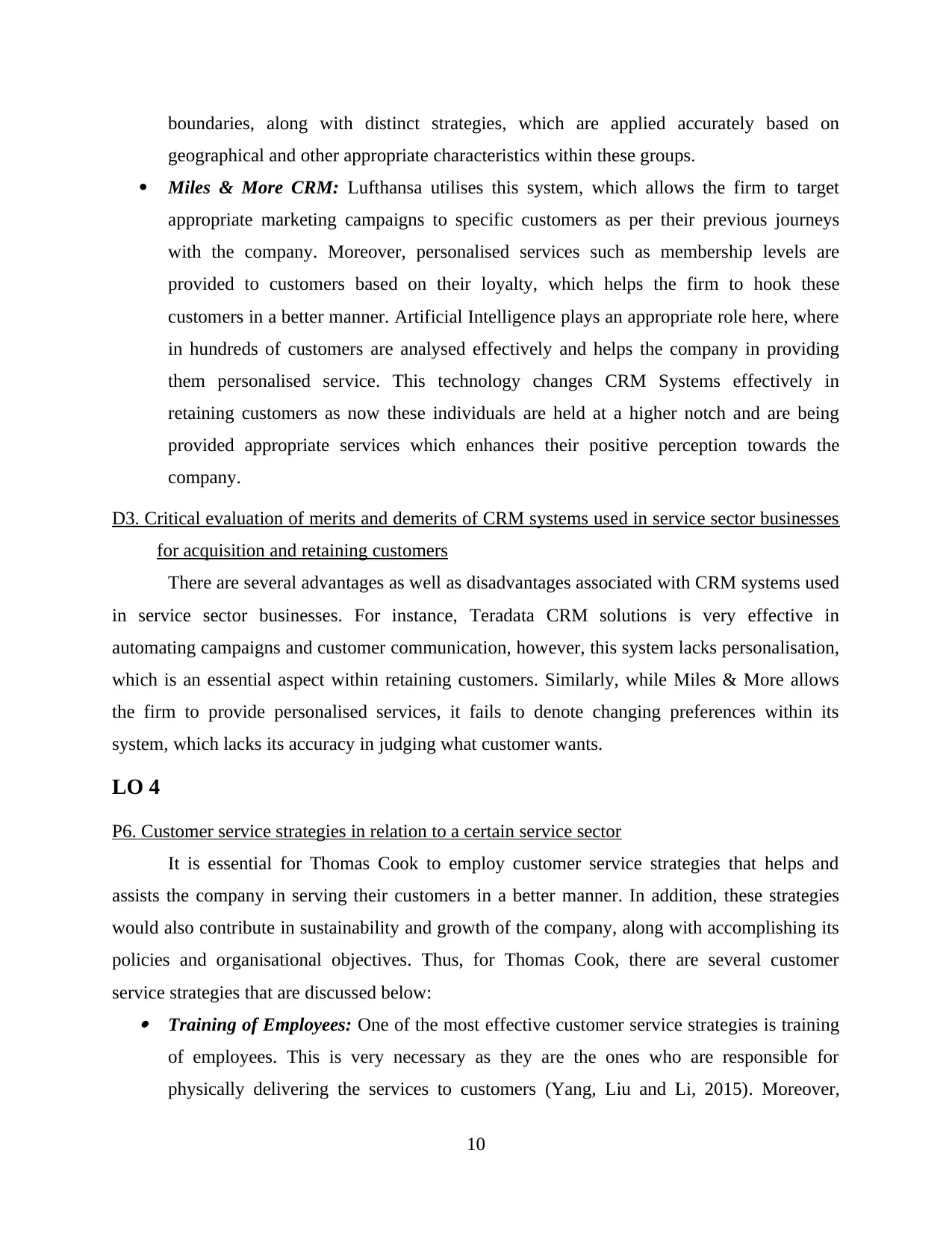
boundaries, along with distinct strategies, which are applied accurately based on
geographical and other appropriate characteristics within these groups.
Miles & More CRM: Lufthansa utilises this system, which allows the firm to target
appropriate marketing campaigns to specific customers as per their previous journeys
with the company. Moreover, personalised services such as membership levels are
provided to customers based on their loyalty, which helps the firm to hook these
customers in a better manner. Artificial Intelligence plays an appropriate role here, where
in hundreds of customers are analysed effectively and helps the company in providing
them personalised service. This technology changes CRM Systems effectively in
retaining customers as now these individuals are held at a higher notch and are being
provided appropriate services which enhances their positive perception towards the
company.
D3. Critical evaluation of merits and demerits of CRM systems used in service sector businesses
for acquisition and retaining customers
There are several advantages as well as disadvantages associated with CRM systems used
in service sector businesses. For instance, Teradata CRM solutions is very effective in
automating campaigns and customer communication, however, this system lacks personalisation,
which is an essential aspect within retaining customers. Similarly, while Miles & More allows
the firm to provide personalised services, it fails to denote changing preferences within its
system, which lacks its accuracy in judging what customer wants.
LO 4
P6. Customer service strategies in relation to a certain service sector
It is essential for Thomas Cook to employ customer service strategies that helps and
assists the company in serving their customers in a better manner. In addition, these strategies
would also contribute in sustainability and growth of the company, along with accomplishing its
policies and organisational objectives. Thus, for Thomas Cook, there are several customer
service strategies that are discussed below: Training of Employees: One of the most effective customer service strategies is training
of employees. This is very necessary as they are the ones who are responsible for
physically delivering the services to customers (Yang, Liu and Li, 2015). Moreover,
10
geographical and other appropriate characteristics within these groups.
Miles & More CRM: Lufthansa utilises this system, which allows the firm to target
appropriate marketing campaigns to specific customers as per their previous journeys
with the company. Moreover, personalised services such as membership levels are
provided to customers based on their loyalty, which helps the firm to hook these
customers in a better manner. Artificial Intelligence plays an appropriate role here, where
in hundreds of customers are analysed effectively and helps the company in providing
them personalised service. This technology changes CRM Systems effectively in
retaining customers as now these individuals are held at a higher notch and are being
provided appropriate services which enhances their positive perception towards the
company.
D3. Critical evaluation of merits and demerits of CRM systems used in service sector businesses
for acquisition and retaining customers
There are several advantages as well as disadvantages associated with CRM systems used
in service sector businesses. For instance, Teradata CRM solutions is very effective in
automating campaigns and customer communication, however, this system lacks personalisation,
which is an essential aspect within retaining customers. Similarly, while Miles & More allows
the firm to provide personalised services, it fails to denote changing preferences within its
system, which lacks its accuracy in judging what customer wants.
LO 4
P6. Customer service strategies in relation to a certain service sector
It is essential for Thomas Cook to employ customer service strategies that helps and
assists the company in serving their customers in a better manner. In addition, these strategies
would also contribute in sustainability and growth of the company, along with accomplishing its
policies and organisational objectives. Thus, for Thomas Cook, there are several customer
service strategies that are discussed below: Training of Employees: One of the most effective customer service strategies is training
of employees. This is very necessary as they are the ones who are responsible for
physically delivering the services to customers (Yang, Liu and Li, 2015). Moreover,
10
Paraphrase This Document
Need a fresh take? Get an instant paraphrase of this document with our AI Paraphraser
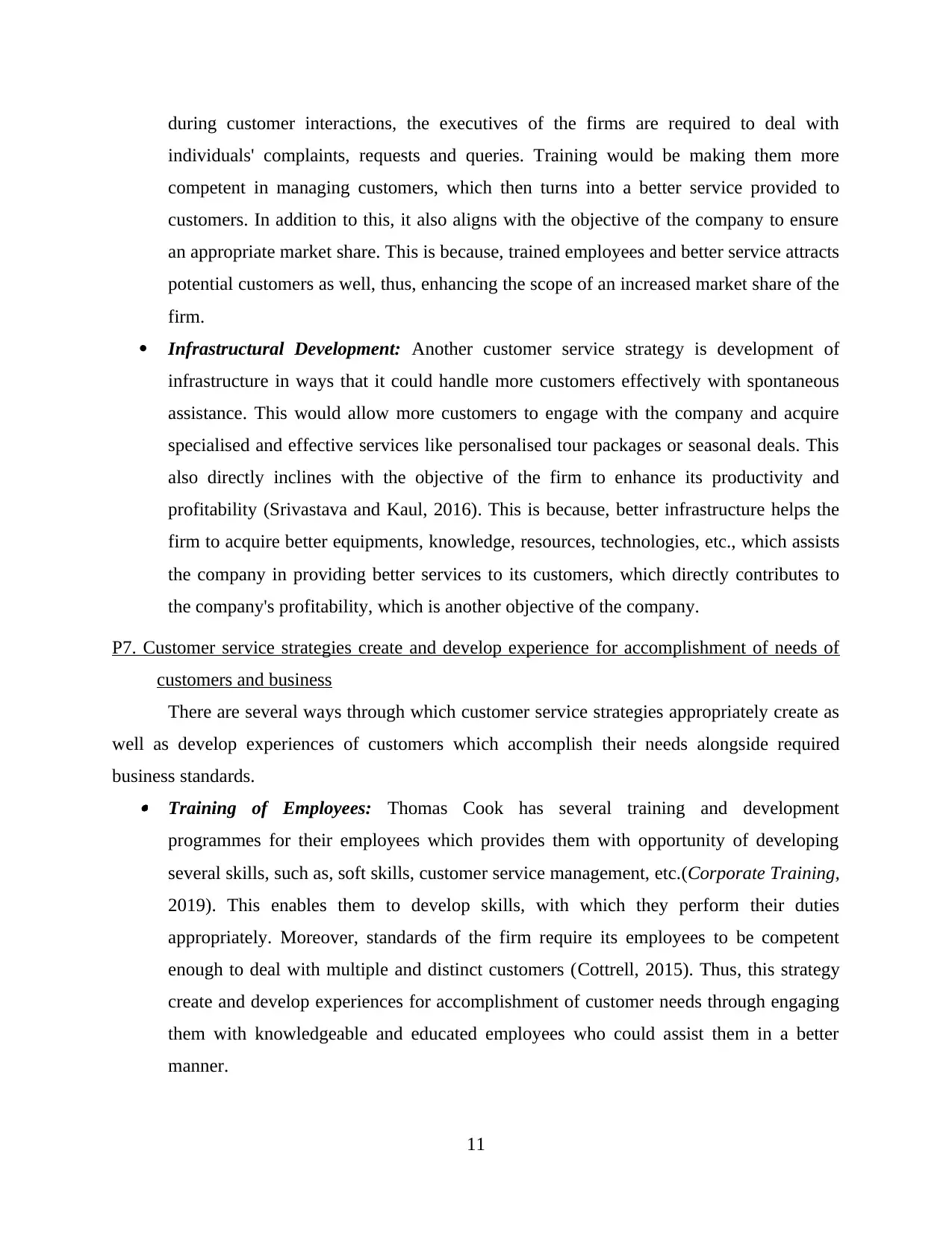
during customer interactions, the executives of the firms are required to deal with
individuals' complaints, requests and queries. Training would be making them more
competent in managing customers, which then turns into a better service provided to
customers. In addition to this, it also aligns with the objective of the company to ensure
an appropriate market share. This is because, trained employees and better service attracts
potential customers as well, thus, enhancing the scope of an increased market share of the
firm.
Infrastructural Development: Another customer service strategy is development of
infrastructure in ways that it could handle more customers effectively with spontaneous
assistance. This would allow more customers to engage with the company and acquire
specialised and effective services like personalised tour packages or seasonal deals. This
also directly inclines with the objective of the firm to enhance its productivity and
profitability (Srivastava and Kaul, 2016). This is because, better infrastructure helps the
firm to acquire better equipments, knowledge, resources, technologies, etc., which assists
the company in providing better services to its customers, which directly contributes to
the company's profitability, which is another objective of the company.
P7. Customer service strategies create and develop experience for accomplishment of needs of
customers and business
There are several ways through which customer service strategies appropriately create as
well as develop experiences of customers which accomplish their needs alongside required
business standards. Training of Employees: Thomas Cook has several training and development
programmes for their employees which provides them with opportunity of developing
several skills, such as, soft skills, customer service management, etc.(Corporate Training,
2019). This enables them to develop skills, with which they perform their duties
appropriately. Moreover, standards of the firm require its employees to be competent
enough to deal with multiple and distinct customers (Cottrell, 2015). Thus, this strategy
create and develop experiences for accomplishment of customer needs through engaging
them with knowledgeable and educated employees who could assist them in a better
manner.
11
individuals' complaints, requests and queries. Training would be making them more
competent in managing customers, which then turns into a better service provided to
customers. In addition to this, it also aligns with the objective of the company to ensure
an appropriate market share. This is because, trained employees and better service attracts
potential customers as well, thus, enhancing the scope of an increased market share of the
firm.
Infrastructural Development: Another customer service strategy is development of
infrastructure in ways that it could handle more customers effectively with spontaneous
assistance. This would allow more customers to engage with the company and acquire
specialised and effective services like personalised tour packages or seasonal deals. This
also directly inclines with the objective of the firm to enhance its productivity and
profitability (Srivastava and Kaul, 2016). This is because, better infrastructure helps the
firm to acquire better equipments, knowledge, resources, technologies, etc., which assists
the company in providing better services to its customers, which directly contributes to
the company's profitability, which is another objective of the company.
P7. Customer service strategies create and develop experience for accomplishment of needs of
customers and business
There are several ways through which customer service strategies appropriately create as
well as develop experiences of customers which accomplish their needs alongside required
business standards. Training of Employees: Thomas Cook has several training and development
programmes for their employees which provides them with opportunity of developing
several skills, such as, soft skills, customer service management, etc.(Corporate Training,
2019). This enables them to develop skills, with which they perform their duties
appropriately. Moreover, standards of the firm require its employees to be competent
enough to deal with multiple and distinct customers (Cottrell, 2015). Thus, this strategy
create and develop experiences for accomplishment of customer needs through engaging
them with knowledgeable and educated employees who could assist them in a better
manner.
11
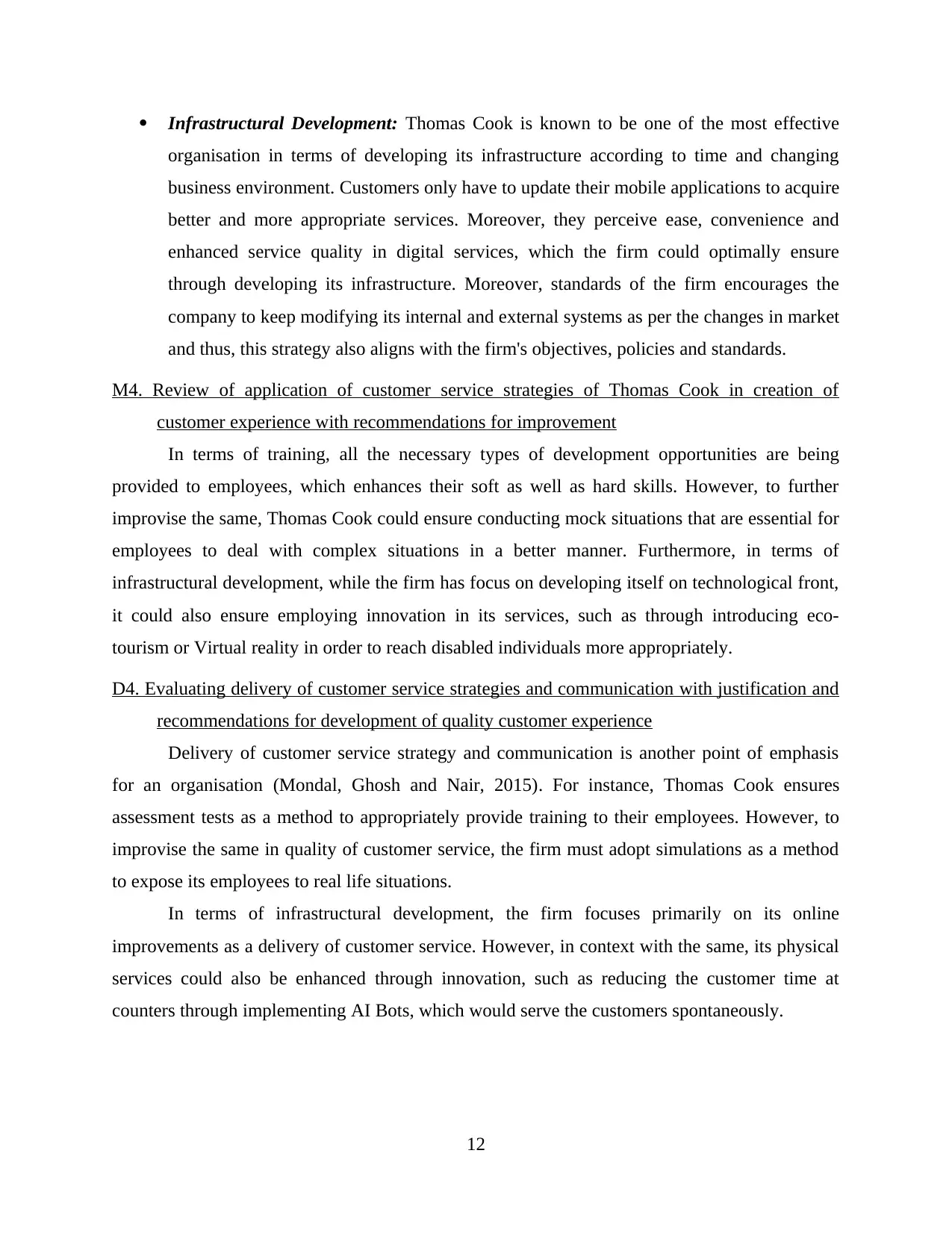
Infrastructural Development: Thomas Cook is known to be one of the most effective
organisation in terms of developing its infrastructure according to time and changing
business environment. Customers only have to update their mobile applications to acquire
better and more appropriate services. Moreover, they perceive ease, convenience and
enhanced service quality in digital services, which the firm could optimally ensure
through developing its infrastructure. Moreover, standards of the firm encourages the
company to keep modifying its internal and external systems as per the changes in market
and thus, this strategy also aligns with the firm's objectives, policies and standards.
M4. Review of application of customer service strategies of Thomas Cook in creation of
customer experience with recommendations for improvement
In terms of training, all the necessary types of development opportunities are being
provided to employees, which enhances their soft as well as hard skills. However, to further
improvise the same, Thomas Cook could ensure conducting mock situations that are essential for
employees to deal with complex situations in a better manner. Furthermore, in terms of
infrastructural development, while the firm has focus on developing itself on technological front,
it could also ensure employing innovation in its services, such as through introducing eco-
tourism or Virtual reality in order to reach disabled individuals more appropriately.
D4. Evaluating delivery of customer service strategies and communication with justification and
recommendations for development of quality customer experience
Delivery of customer service strategy and communication is another point of emphasis
for an organisation (Mondal, Ghosh and Nair, 2015). For instance, Thomas Cook ensures
assessment tests as a method to appropriately provide training to their employees. However, to
improvise the same in quality of customer service, the firm must adopt simulations as a method
to expose its employees to real life situations.
In terms of infrastructural development, the firm focuses primarily on its online
improvements as a delivery of customer service. However, in context with the same, its physical
services could also be enhanced through innovation, such as reducing the customer time at
counters through implementing AI Bots, which would serve the customers spontaneously.
12
organisation in terms of developing its infrastructure according to time and changing
business environment. Customers only have to update their mobile applications to acquire
better and more appropriate services. Moreover, they perceive ease, convenience and
enhanced service quality in digital services, which the firm could optimally ensure
through developing its infrastructure. Moreover, standards of the firm encourages the
company to keep modifying its internal and external systems as per the changes in market
and thus, this strategy also aligns with the firm's objectives, policies and standards.
M4. Review of application of customer service strategies of Thomas Cook in creation of
customer experience with recommendations for improvement
In terms of training, all the necessary types of development opportunities are being
provided to employees, which enhances their soft as well as hard skills. However, to further
improvise the same, Thomas Cook could ensure conducting mock situations that are essential for
employees to deal with complex situations in a better manner. Furthermore, in terms of
infrastructural development, while the firm has focus on developing itself on technological front,
it could also ensure employing innovation in its services, such as through introducing eco-
tourism or Virtual reality in order to reach disabled individuals more appropriately.
D4. Evaluating delivery of customer service strategies and communication with justification and
recommendations for development of quality customer experience
Delivery of customer service strategy and communication is another point of emphasis
for an organisation (Mondal, Ghosh and Nair, 2015). For instance, Thomas Cook ensures
assessment tests as a method to appropriately provide training to their employees. However, to
improvise the same in quality of customer service, the firm must adopt simulations as a method
to expose its employees to real life situations.
In terms of infrastructural development, the firm focuses primarily on its online
improvements as a delivery of customer service. However, in context with the same, its physical
services could also be enhanced through innovation, such as reducing the customer time at
counters through implementing AI Bots, which would serve the customers spontaneously.
12
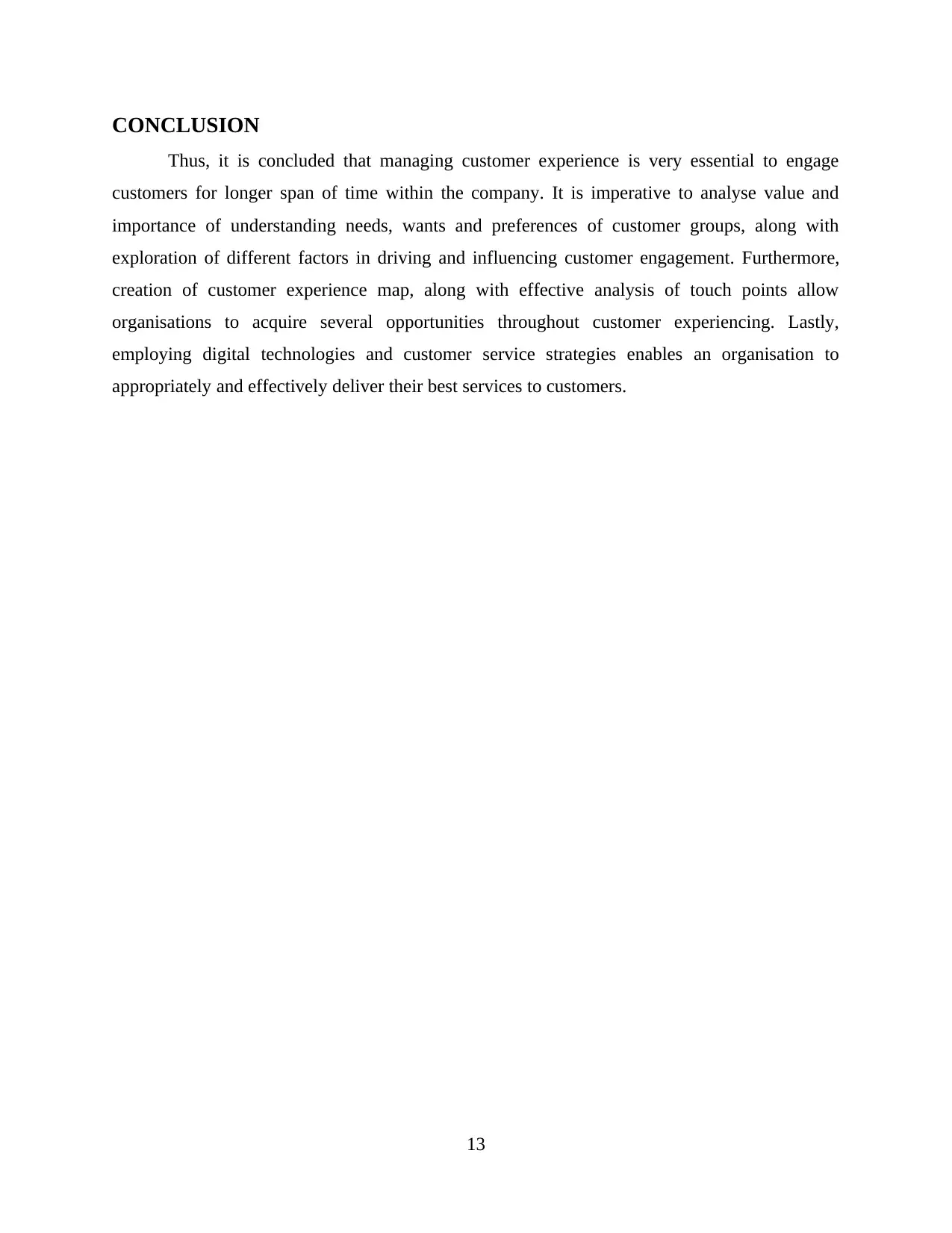
CONCLUSION
Thus, it is concluded that managing customer experience is very essential to engage
customers for longer span of time within the company. It is imperative to analyse value and
importance of understanding needs, wants and preferences of customer groups, along with
exploration of different factors in driving and influencing customer engagement. Furthermore,
creation of customer experience map, along with effective analysis of touch points allow
organisations to acquire several opportunities throughout customer experiencing. Lastly,
employing digital technologies and customer service strategies enables an organisation to
appropriately and effectively deliver their best services to customers.
13
Thus, it is concluded that managing customer experience is very essential to engage
customers for longer span of time within the company. It is imperative to analyse value and
importance of understanding needs, wants and preferences of customer groups, along with
exploration of different factors in driving and influencing customer engagement. Furthermore,
creation of customer experience map, along with effective analysis of touch points allow
organisations to acquire several opportunities throughout customer experiencing. Lastly,
employing digital technologies and customer service strategies enables an organisation to
appropriately and effectively deliver their best services to customers.
13
Secure Best Marks with AI Grader
Need help grading? Try our AI Grader for instant feedback on your assignments.
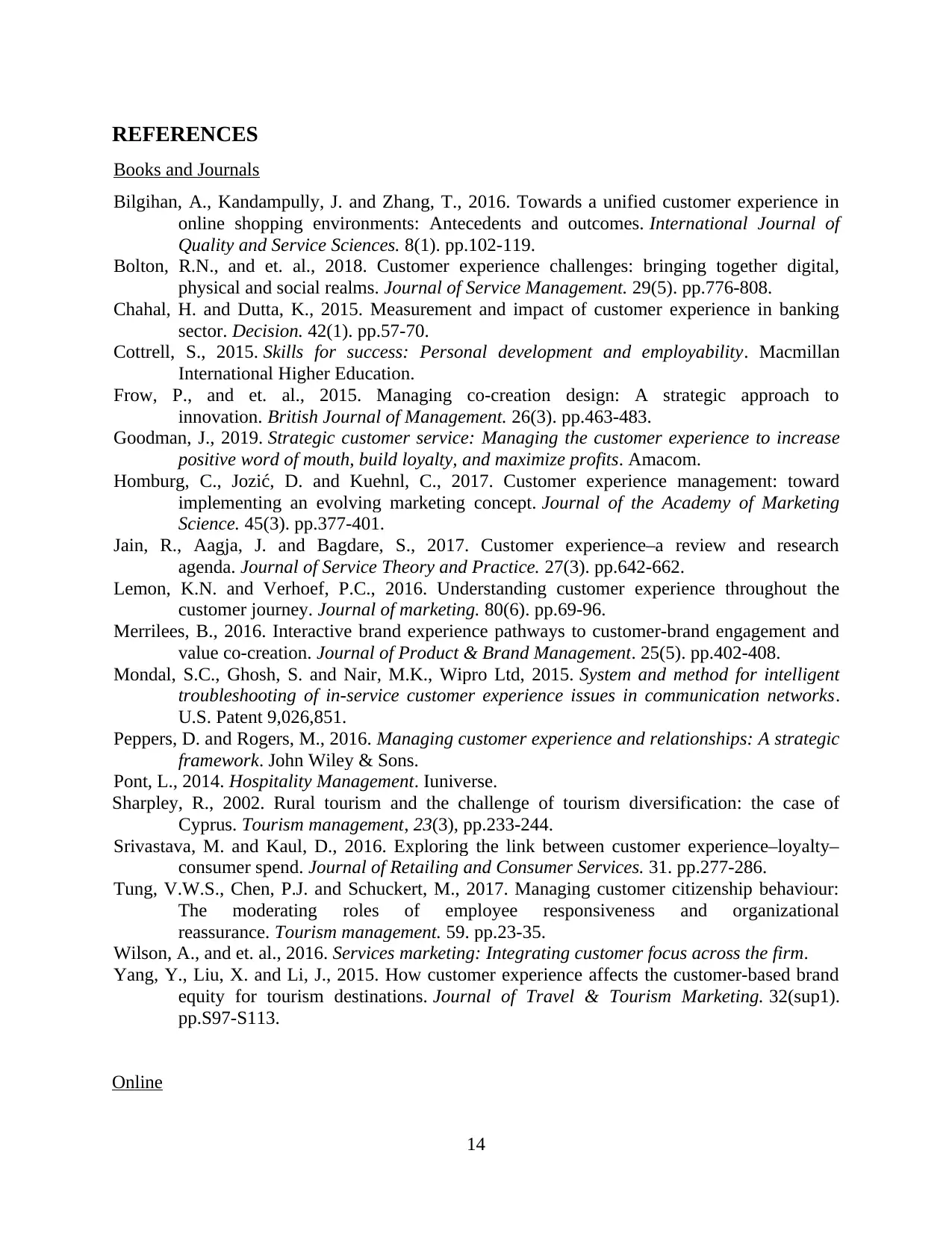
REFERENCES
Books and Journals
Bilgihan, A., Kandampully, J. and Zhang, T., 2016. Towards a unified customer experience in
online shopping environments: Antecedents and outcomes. International Journal of
Quality and Service Sciences. 8(1). pp.102-119.
Bolton, R.N., and et. al., 2018. Customer experience challenges: bringing together digital,
physical and social realms. Journal of Service Management. 29(5). pp.776-808.
Chahal, H. and Dutta, K., 2015. Measurement and impact of customer experience in banking
sector. Decision. 42(1). pp.57-70.
Cottrell, S., 2015. Skills for success: Personal development and employability. Macmillan
International Higher Education.
Frow, P., and et. al., 2015. Managing co‐creation design: A strategic approach to
innovation. British Journal of Management. 26(3). pp.463-483.
Goodman, J., 2019. Strategic customer service: Managing the customer experience to increase
positive word of mouth, build loyalty, and maximize profits. Amacom.
Homburg, C., Jozić, D. and Kuehnl, C., 2017. Customer experience management: toward
implementing an evolving marketing concept. Journal of the Academy of Marketing
Science. 45(3). pp.377-401.
Jain, R., Aagja, J. and Bagdare, S., 2017. Customer experience–a review and research
agenda. Journal of Service Theory and Practice. 27(3). pp.642-662.
Lemon, K.N. and Verhoef, P.C., 2016. Understanding customer experience throughout the
customer journey. Journal of marketing. 80(6). pp.69-96.
Merrilees, B., 2016. Interactive brand experience pathways to customer-brand engagement and
value co-creation. Journal of Product & Brand Management. 25(5). pp.402-408.
Mondal, S.C., Ghosh, S. and Nair, M.K., Wipro Ltd, 2015. System and method for intelligent
troubleshooting of in-service customer experience issues in communication networks.
U.S. Patent 9,026,851.
Peppers, D. and Rogers, M., 2016. Managing customer experience and relationships: A strategic
framework. John Wiley & Sons.
Pont, L., 2014. Hospitality Management. Iuniverse.
Sharpley, R., 2002. Rural tourism and the challenge of tourism diversification: the case of
Cyprus. Tourism management, 23(3), pp.233-244.
Srivastava, M. and Kaul, D., 2016. Exploring the link between customer experience–loyalty–
consumer spend. Journal of Retailing and Consumer Services. 31. pp.277-286.
Tung, V.W.S., Chen, P.J. and Schuckert, M., 2017. Managing customer citizenship behaviour:
The moderating roles of employee responsiveness and organizational
reassurance. Tourism management. 59. pp.23-35.
Wilson, A., and et. al., 2016. Services marketing: Integrating customer focus across the firm.
Yang, Y., Liu, X. and Li, J., 2015. How customer experience affects the customer-based brand
equity for tourism destinations. Journal of Travel & Tourism Marketing. 32(sup1).
pp.S97-S113.
Online
14
Books and Journals
Bilgihan, A., Kandampully, J. and Zhang, T., 2016. Towards a unified customer experience in
online shopping environments: Antecedents and outcomes. International Journal of
Quality and Service Sciences. 8(1). pp.102-119.
Bolton, R.N., and et. al., 2018. Customer experience challenges: bringing together digital,
physical and social realms. Journal of Service Management. 29(5). pp.776-808.
Chahal, H. and Dutta, K., 2015. Measurement and impact of customer experience in banking
sector. Decision. 42(1). pp.57-70.
Cottrell, S., 2015. Skills for success: Personal development and employability. Macmillan
International Higher Education.
Frow, P., and et. al., 2015. Managing co‐creation design: A strategic approach to
innovation. British Journal of Management. 26(3). pp.463-483.
Goodman, J., 2019. Strategic customer service: Managing the customer experience to increase
positive word of mouth, build loyalty, and maximize profits. Amacom.
Homburg, C., Jozić, D. and Kuehnl, C., 2017. Customer experience management: toward
implementing an evolving marketing concept. Journal of the Academy of Marketing
Science. 45(3). pp.377-401.
Jain, R., Aagja, J. and Bagdare, S., 2017. Customer experience–a review and research
agenda. Journal of Service Theory and Practice. 27(3). pp.642-662.
Lemon, K.N. and Verhoef, P.C., 2016. Understanding customer experience throughout the
customer journey. Journal of marketing. 80(6). pp.69-96.
Merrilees, B., 2016. Interactive brand experience pathways to customer-brand engagement and
value co-creation. Journal of Product & Brand Management. 25(5). pp.402-408.
Mondal, S.C., Ghosh, S. and Nair, M.K., Wipro Ltd, 2015. System and method for intelligent
troubleshooting of in-service customer experience issues in communication networks.
U.S. Patent 9,026,851.
Peppers, D. and Rogers, M., 2016. Managing customer experience and relationships: A strategic
framework. John Wiley & Sons.
Pont, L., 2014. Hospitality Management. Iuniverse.
Sharpley, R., 2002. Rural tourism and the challenge of tourism diversification: the case of
Cyprus. Tourism management, 23(3), pp.233-244.
Srivastava, M. and Kaul, D., 2016. Exploring the link between customer experience–loyalty–
consumer spend. Journal of Retailing and Consumer Services. 31. pp.277-286.
Tung, V.W.S., Chen, P.J. and Schuckert, M., 2017. Managing customer citizenship behaviour:
The moderating roles of employee responsiveness and organizational
reassurance. Tourism management. 59. pp.23-35.
Wilson, A., and et. al., 2016. Services marketing: Integrating customer focus across the firm.
Yang, Y., Liu, X. and Li, J., 2015. How customer experience affects the customer-based brand
equity for tourism destinations. Journal of Travel & Tourism Marketing. 32(sup1).
pp.S97-S113.
Online
14
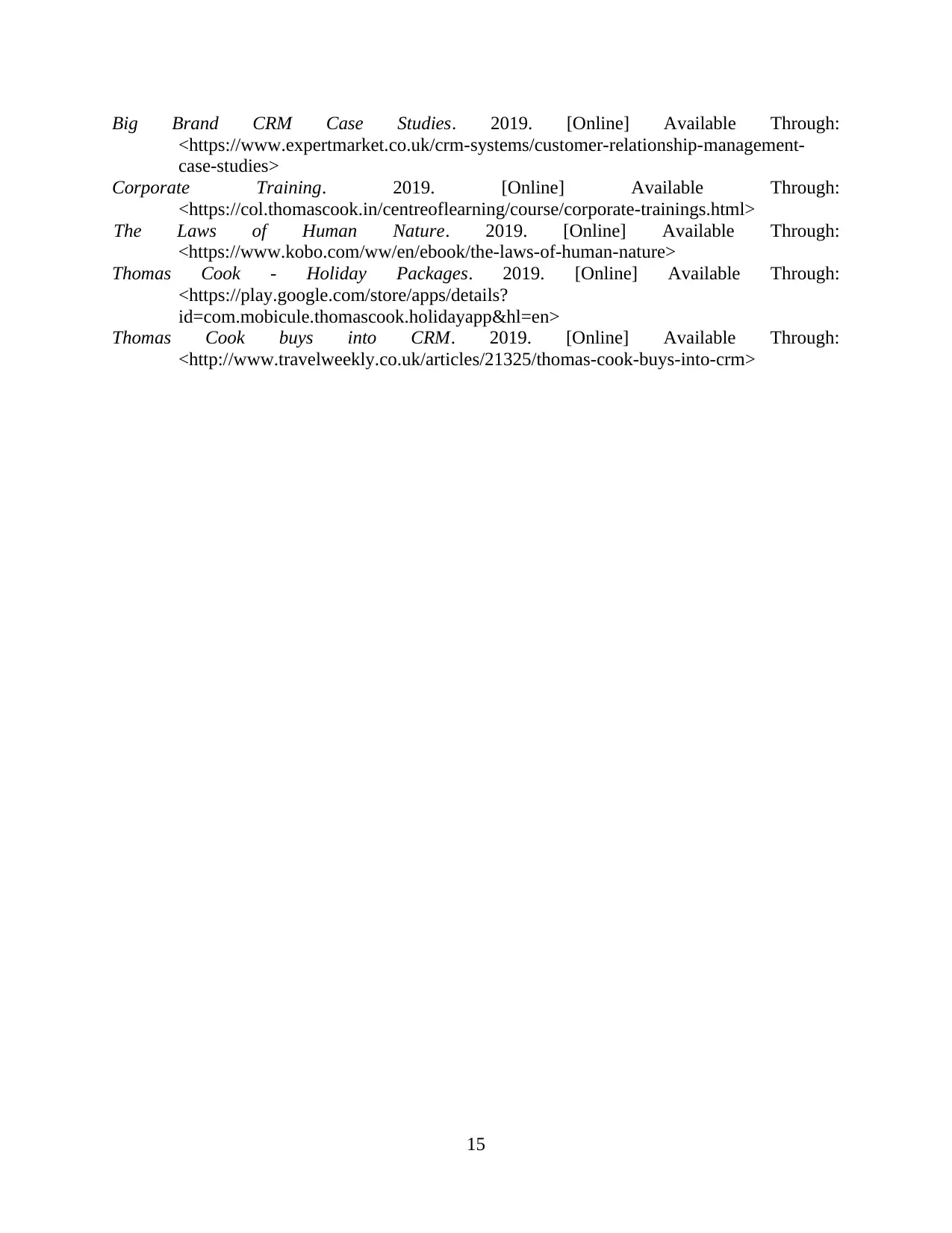
Big Brand CRM Case Studies. 2019. [Online] Available Through:
<https://www.expertmarket.co.uk/crm-systems/customer-relationship-management-
case-studies>
Corporate Training. 2019. [Online] Available Through:
<https://col.thomascook.in/centreoflearning/course/corporate-trainings.html>
The Laws of Human Nature. 2019. [Online] Available Through:
<https://www.kobo.com/ww/en/ebook/the-laws-of-human-nature>
Thomas Cook - Holiday Packages. 2019. [Online] Available Through:
<https://play.google.com/store/apps/details?
id=com.mobicule.thomascook.holidayapp&hl=en>
Thomas Cook buys into CRM. 2019. [Online] Available Through:
<http://www.travelweekly.co.uk/articles/21325/thomas-cook-buys-into-crm>
15
<https://www.expertmarket.co.uk/crm-systems/customer-relationship-management-
case-studies>
Corporate Training. 2019. [Online] Available Through:
<https://col.thomascook.in/centreoflearning/course/corporate-trainings.html>
The Laws of Human Nature. 2019. [Online] Available Through:
<https://www.kobo.com/ww/en/ebook/the-laws-of-human-nature>
Thomas Cook - Holiday Packages. 2019. [Online] Available Through:
<https://play.google.com/store/apps/details?
id=com.mobicule.thomascook.holidayapp&hl=en>
Thomas Cook buys into CRM. 2019. [Online] Available Through:
<http://www.travelweekly.co.uk/articles/21325/thomas-cook-buys-into-crm>
15
1 out of 18
Related Documents
Your All-in-One AI-Powered Toolkit for Academic Success.
+13062052269
info@desklib.com
Available 24*7 on WhatsApp / Email
![[object Object]](/_next/static/media/star-bottom.7253800d.svg)
Unlock your academic potential
© 2024 | Zucol Services PVT LTD | All rights reserved.





